Easy Way to Create a Wall for Privacy
If you are looking for shade and privacy, these garden screening ideas will improve your outside space while enhancing design. From living screens created with the help of dense shrubs to chic metal panels perfect for contemporary gardens a screen not only has a functional use, but can add depth and interest to your yard.
There are loads of ideas for your garden to add screening and it isn't just a case of putting up fences. First, think about what the screen is for. Perhaps you want to create a private space away from nosy neighbours? Or you could be looking to add some structure to a long thin garden by breaking it into rooms. It could be a screen is the only way to add shade to an overly sunny spot.
Screening can also be achieved through your planting scheme, adding not only privacy but a way to make the most of vertical foliage.
With careful consideration of style, screening materials and positioning, you'll be able to make your space more private in a way that suits your needs, tastes, and budget. From clever fence ideas to simple planting solutions, see some of our favourite ways to screen.
1. Work with your garden's boundaries
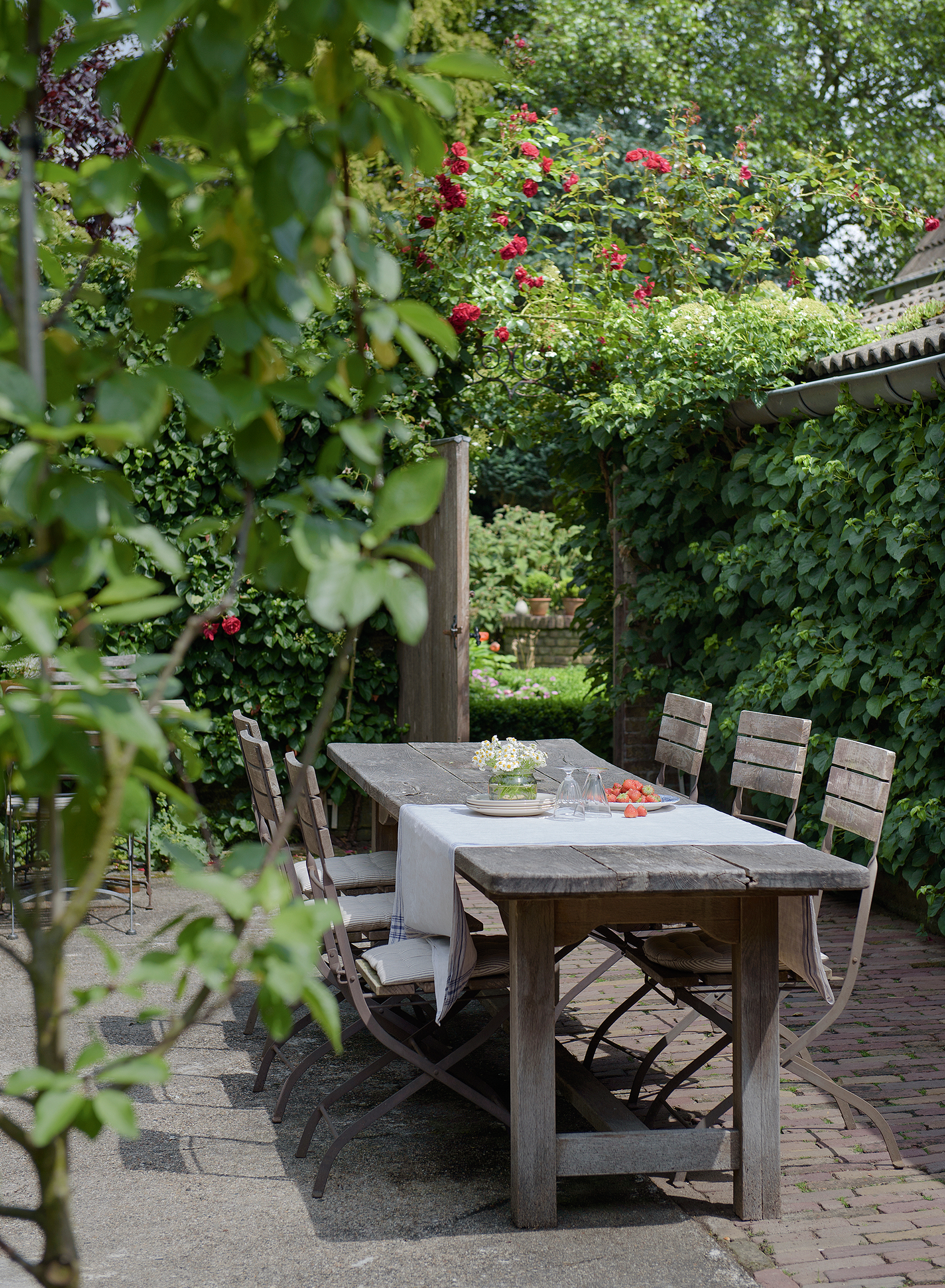
(Image credit: Ton Bouwer/ cocofeatures.com)
Working with your garden's natural boundaries is one of the first things to consider when looking for more privacy in your space. Depending on your garden's size, soil conditions and light levels, you could plant deciduous trees with light airy foliage such as Betula, Amelanchier, Cornus, Malus, Prunus, Acer and Sorbus.
This can provide gentle screening on a boundary area yet still let some sunlight through. And at this stage if you already know you want or need to add a boundary wall, you can start getting that project underway.
Top tip: Building regulations in the UK state that a garden boundary, fence, wall or thick hedge should not exceed two metres in height. You may also need to check boundary laws in your area elsewhere.
2. Balance evergreens and deciduous options
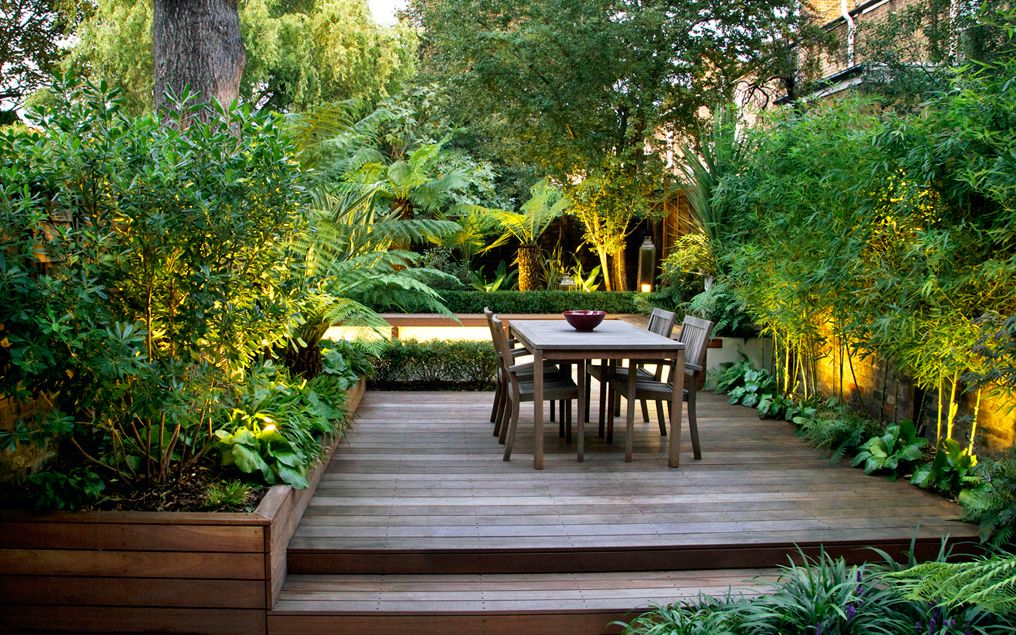
(Image credit: My Landscapes)
If you actually love the idea of full on privacy (and trees!) then choose a mix of deciduous trees with strategically placed evergreens for a more balanced privacy solution that will give you gorgeous dappled light also.
Alternatively, a canopy of deciduous trees can often provide a sense of privacy quickly. Bamboo (see above) is a fantastic instant screen, too. It grows quickly and is green all year around.
3. Work with a sloping garden
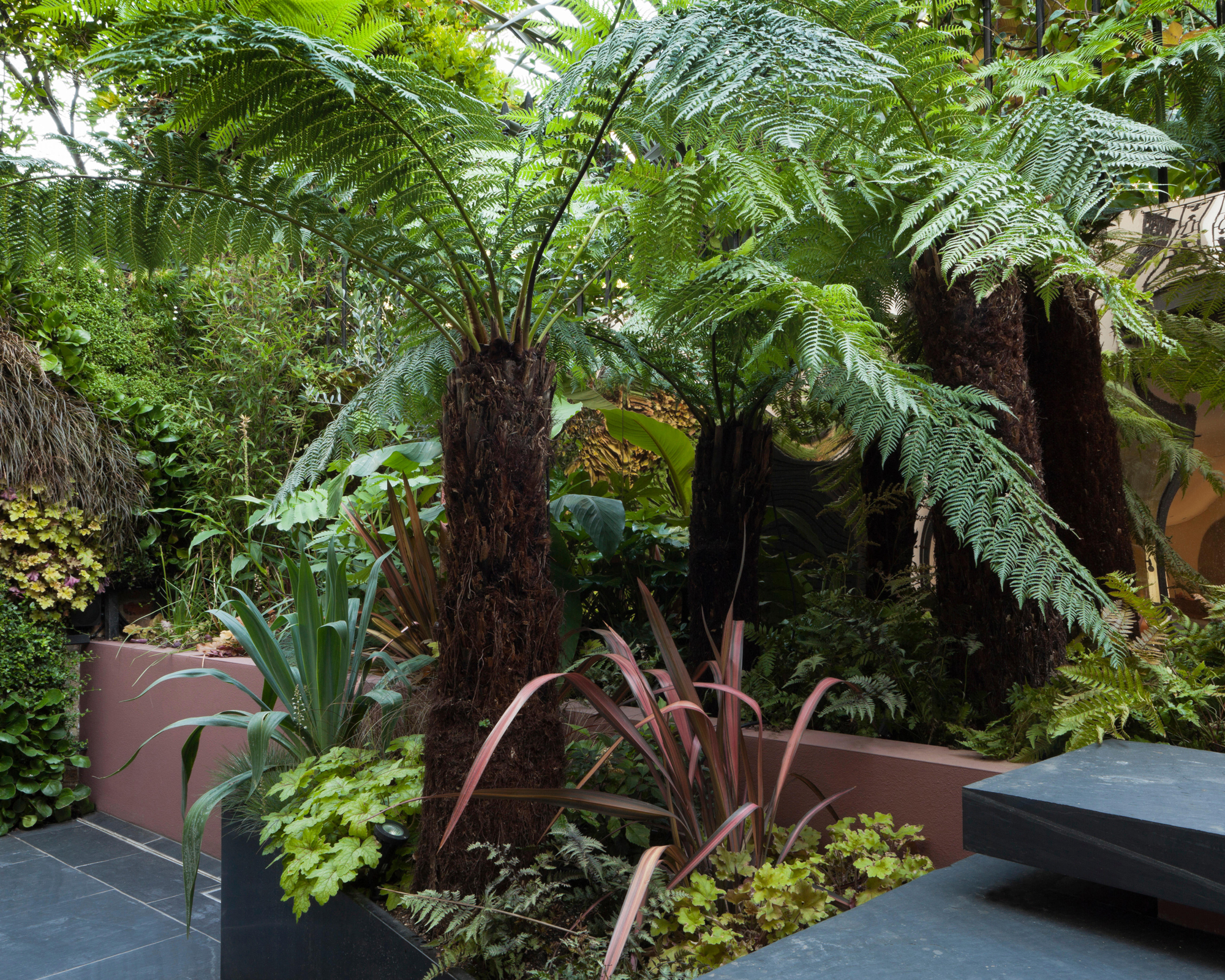
Patio garden at basement level showing slate steps, raised bed and powder-coated steel planter, with tree ferns, ferns, melianthus, phormiums, ornamental grass, banana and olive trees, bamboo and yucca.
(Image credit: Arcaid Images / Alamy Stock Photo)
If your garden is sloped but overlooked, you can use this in your favor. A retaining wall may be enough in itself, but add more greenery to that first level for heaps more interest, height, and, therefore, privacy.
Bonnet says: 'Evergreen shrubs are good to achieve a reliable height and plentiful foliage for privacy all year round. But for a more colorful and bright look, add a few large plants such as hardy palms or phormiums – they are forgiving when they haven't been watered, too.'
Add some tree ferns for additional screening – they look wonderful in tiered and sunken gardens. This screening option is an effective sloping garden idea that will work year-round.
4. Layer container plants for a dense and textured screen
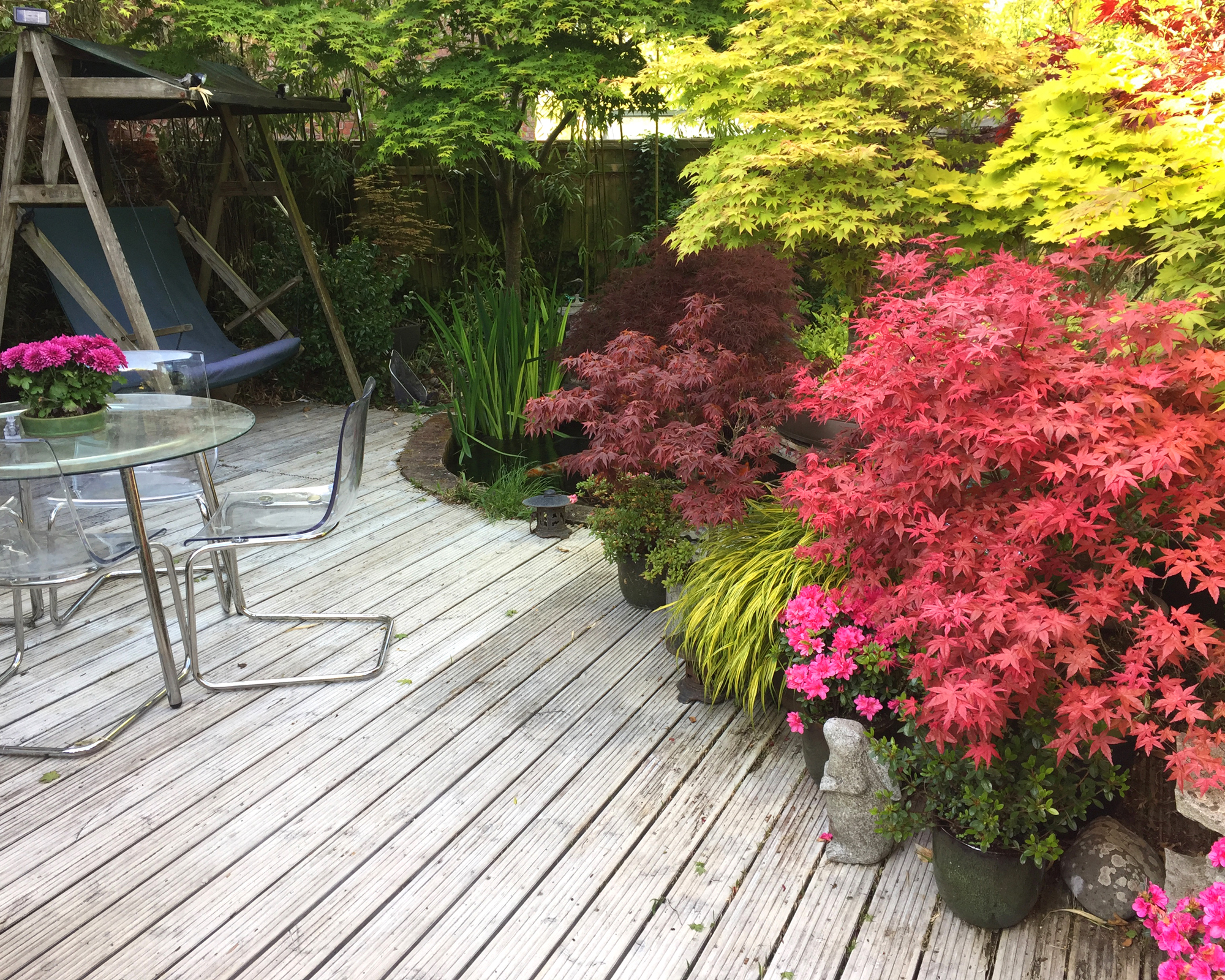
(Image credit: mtreasure / Getty)
Container gardening is the perfect tool for DIY garden screening. Choose pots of different sizes and plants of varying maturity – this will give you both height and density to play with. Japanese maples are especially effective for garden screening, with their bushy, dense canopies. And they do very well in containers.
5. Use a canopy or shade for overhead protection
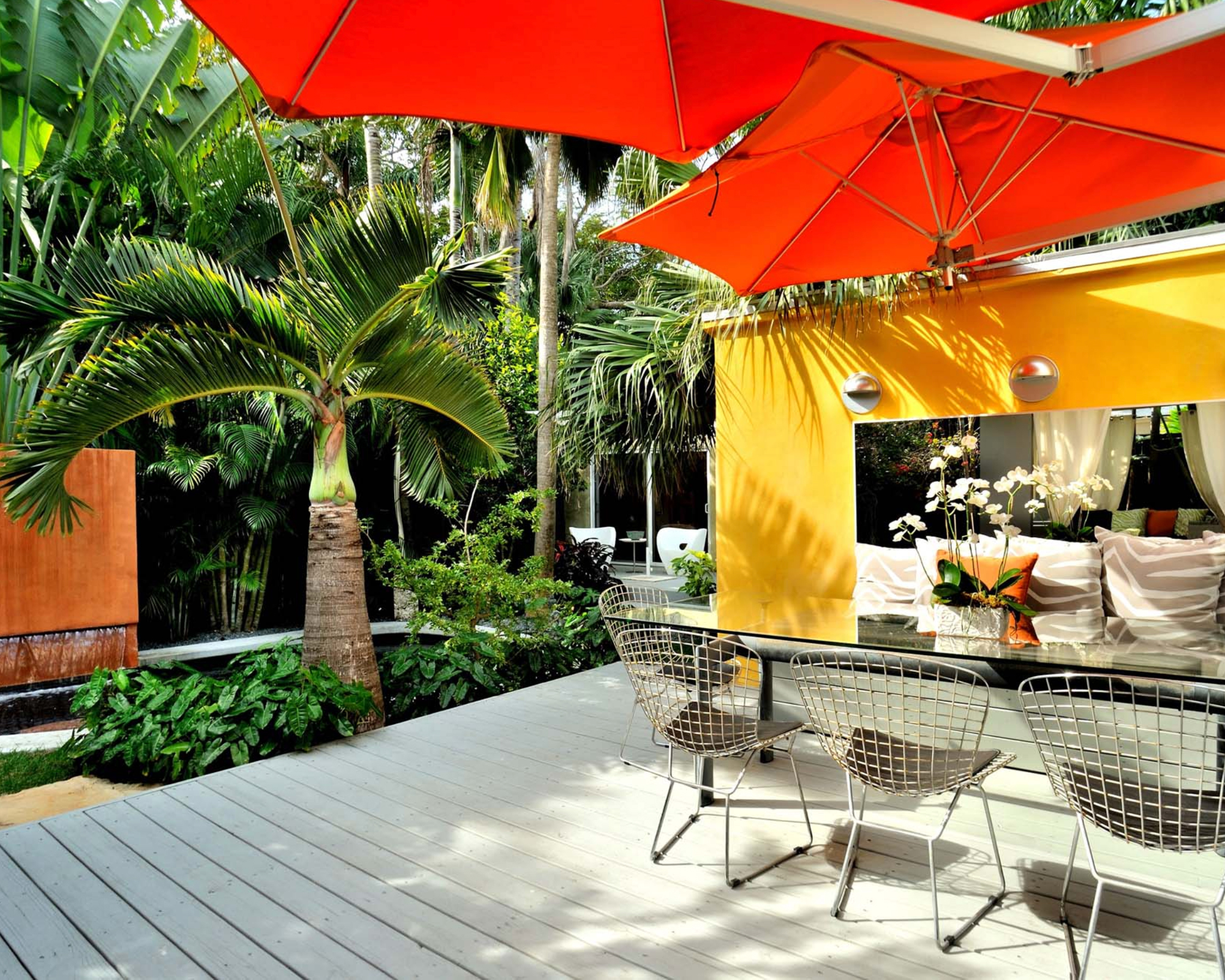
A backyard deck in Key West, Florida, designed by Debra Yates (opens in new tab)
(Image credit: Debra Yates)
For a little cover over a decking area where you tend to wine and dine, a fabric canopy can be a lovely and organic-looking choice. Deck shade ideas come in a variety of materials and styles, but a mobile fabric shade or sail is best because you can tilt it as the sun moves and position it where you need the most privacy.
6. DIY a garden screen
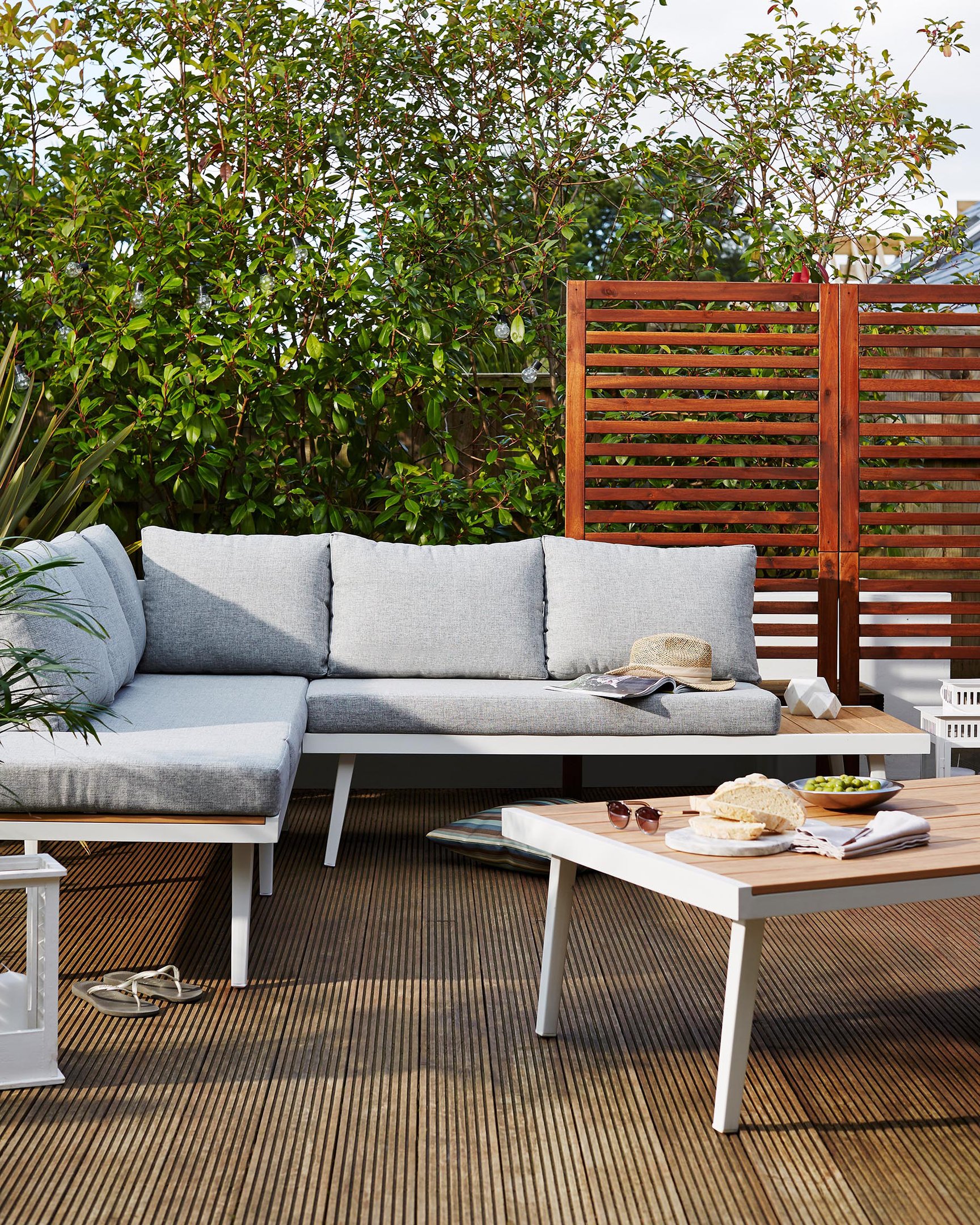
(Image credit: Danetti)
Building your own privacy screen is a great way to use up leftover wood or even old doors.
Bonnet says: 'Privacy screens are the ultimate easy garden DIY project to achieve a concealed area. Apart from nails and a hammer, the quirky yet functional partition can be made solely out of old doors or wooden pallets. To brighten up a dull garden, give the screen a lick of bright paint.'
7. Carefully consider the positioning of outbuildings
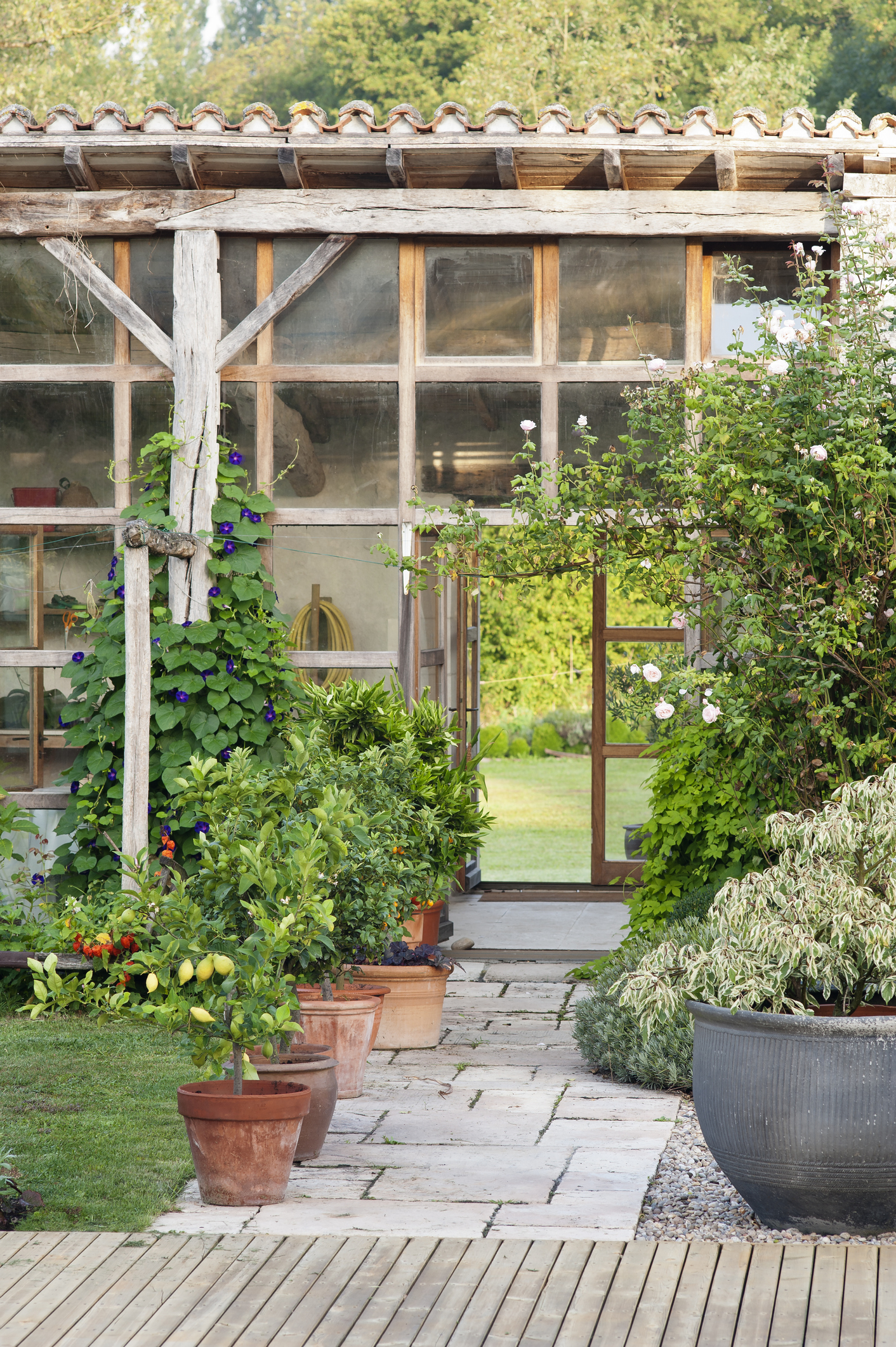
(Image credit: Getty Images)
Whether you're intrigued as to how to build a garden room from scratch or looking to add another type of outbuilding to your backyard, think about its positioning to help the flow of your space as a whole but also to block out any spots you want to keep totally private.
8. Choose low seating in a built up courtyard
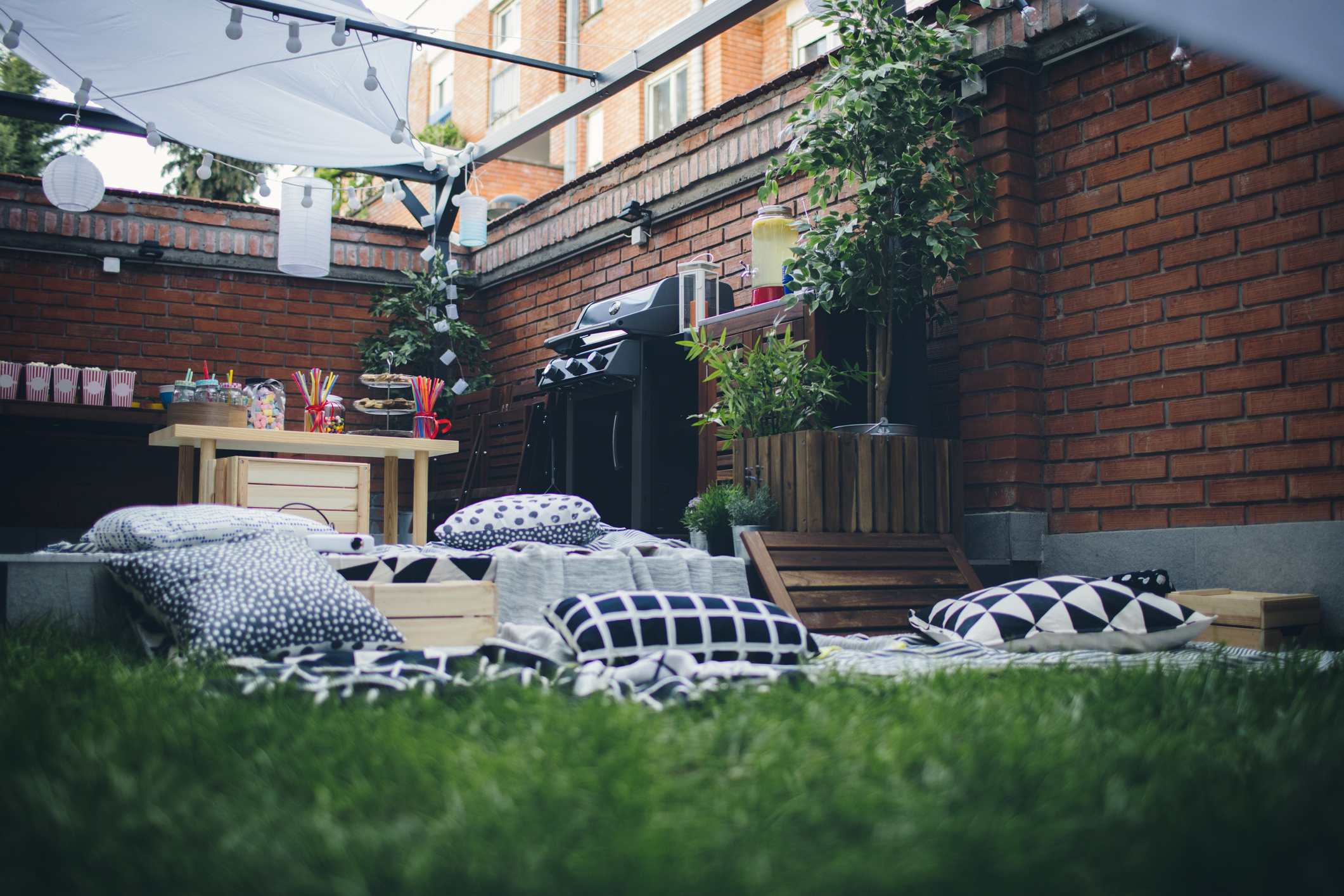
(Image credit: Getty Images)
If you need privacy from up above where you are in an enclosed space, such as a garden patio, choosing low seating is not only cozy but also a simple way to feel more comfortable from onlookers.
Deter attention further and up the decorative factor by stringing garden lighting and other accessories across the opening to stylishly obstruct the view from the outside.
9. Choose climbers instead of traditional hedging

(Image credit: Photograph Leigh Clapp)
We're a bit over traditional hedging, which can look too solid and a bit severe. Consider screening off areas within the garden using shrubs or climbing plants as opposed to blocking your whole boundary.
Perfect for areas where you'd like a more permanent privacy solution, climbers such as ivy, jasmine, clematis, and roses offer maximum screening power without creating an overly boxed-in look.
10. Get a contemporary divider
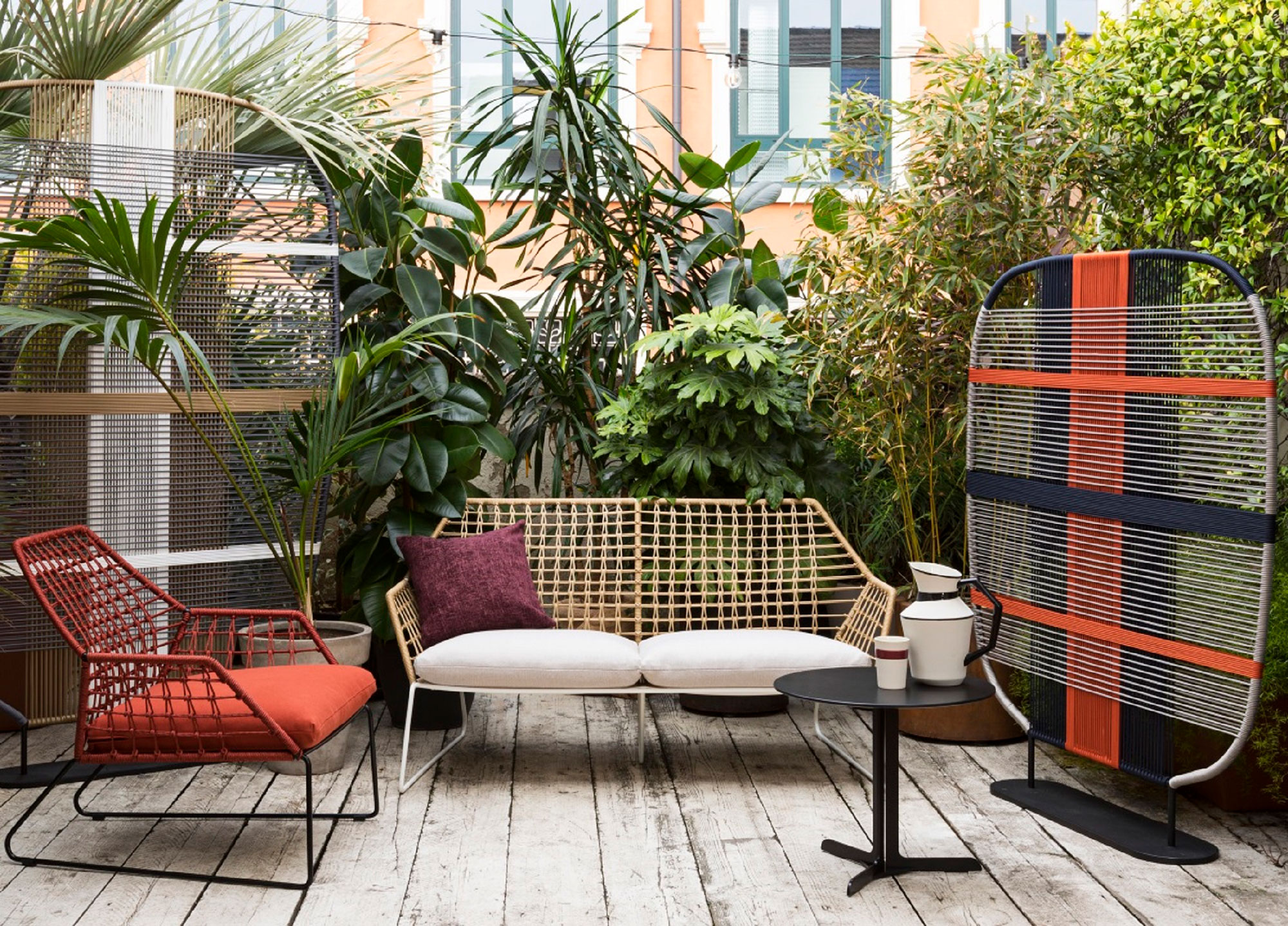
(Image credit: Beaumonde)
You can also create a little more privacy using a dedicated outdoor space divider. These are great for contemporary spaces and they create barriers but are light and still allow for some visibility. Perfect if you have an outdoor kitchen or cocktail space.
11. Set up that outdoor cinema you've been dreaming of

(Image credit: Getty Images)
Invest in an outdoor projector and put up the big screen in your garden for a cinematic experience that will not only look good but also feel super-exclusive.
Hang your screen in a spot where you want to block sightlines out, grab your favorite outdoor rug, lots of cushions, all the popcorn you can eat – and voila, you have the perfect setup that is only yours to enjoy.
12. Be bold with a parasol
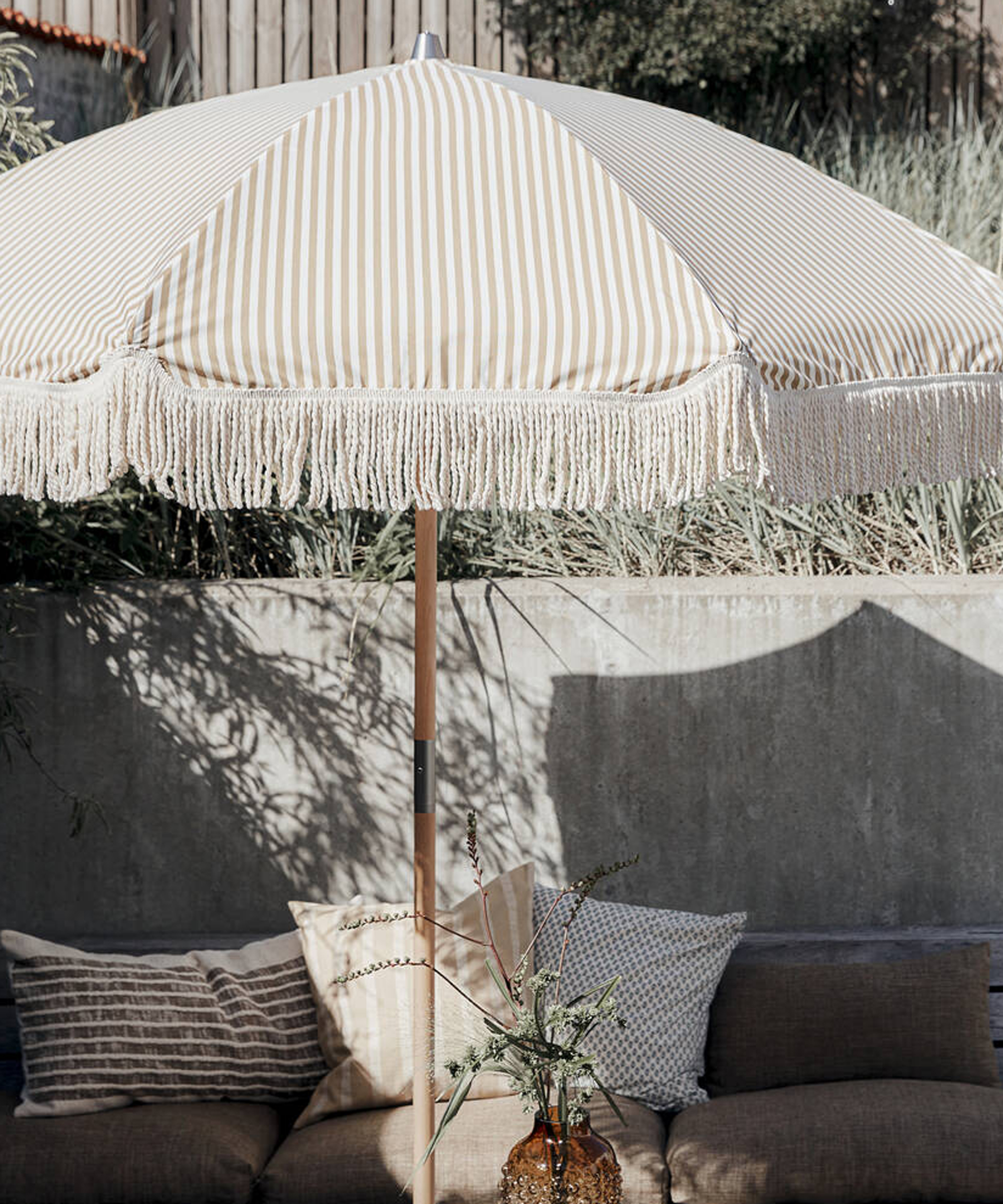
(Image credit: Ella James )
For a temporary solution, a cantilever umbrella or another of the best parasols about can provide flexible privacy. Easy to install, one of the cheaper garden screening ideas going, and stylish if you look in the right places, a parasol will make a classy addition to your patio.
13. Plant fast-growing annuals for a near-instant screen
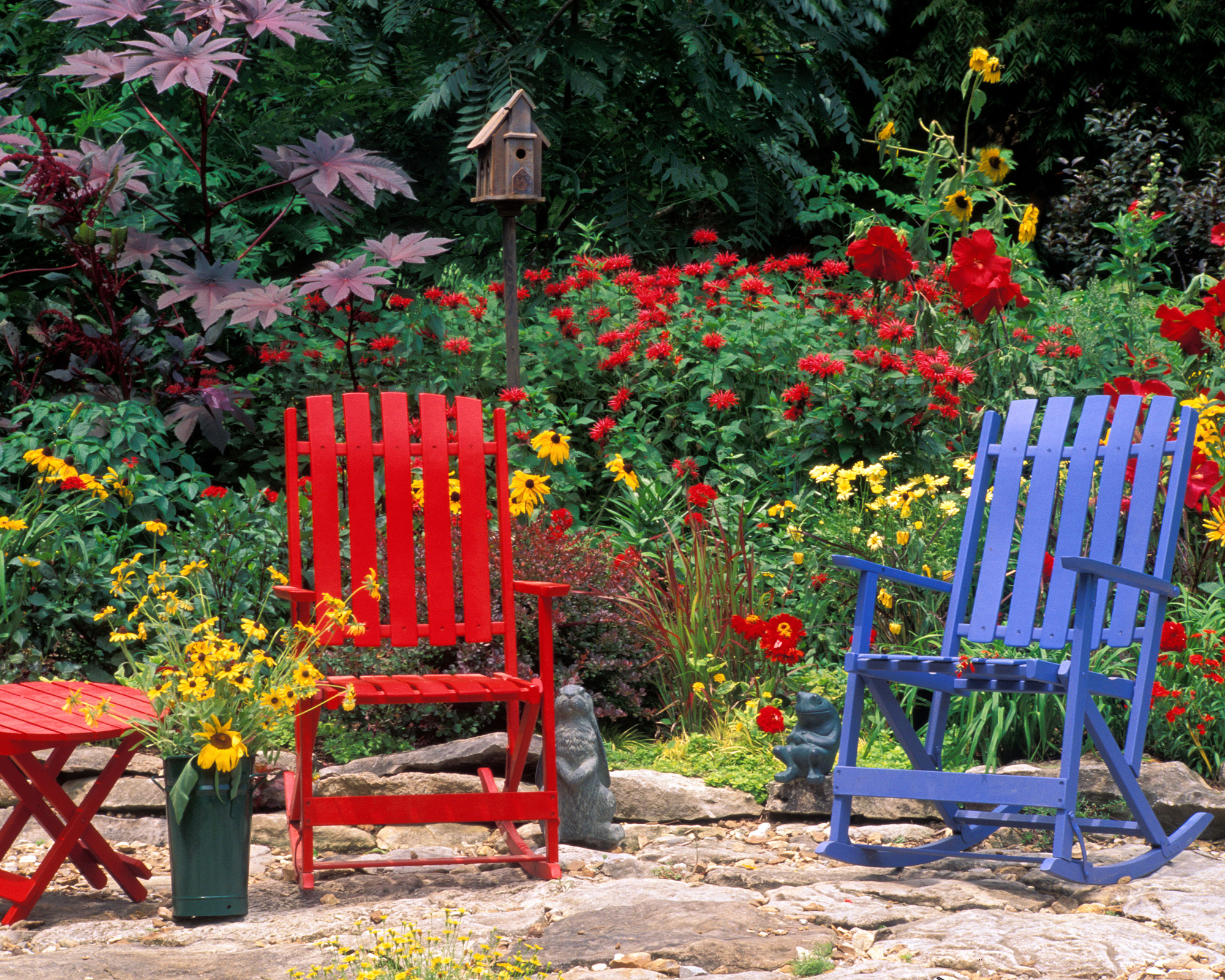
(Image credit: Gay Bumgarner / Alamy Stock Photo)
Want an inexpensive, DIY solution to an exposed garden quickly? There's an easy answer – fast-growing annual flowers. Consider easy-to-grow flowers such as zinnias, cosmos, and sunflowers to plug in any gaps in your existing screening. By late June-early July you will have a gorgeous display that will enhance your garden's privacy.
14. Or plant tall bi-annuals for maximum screening potential
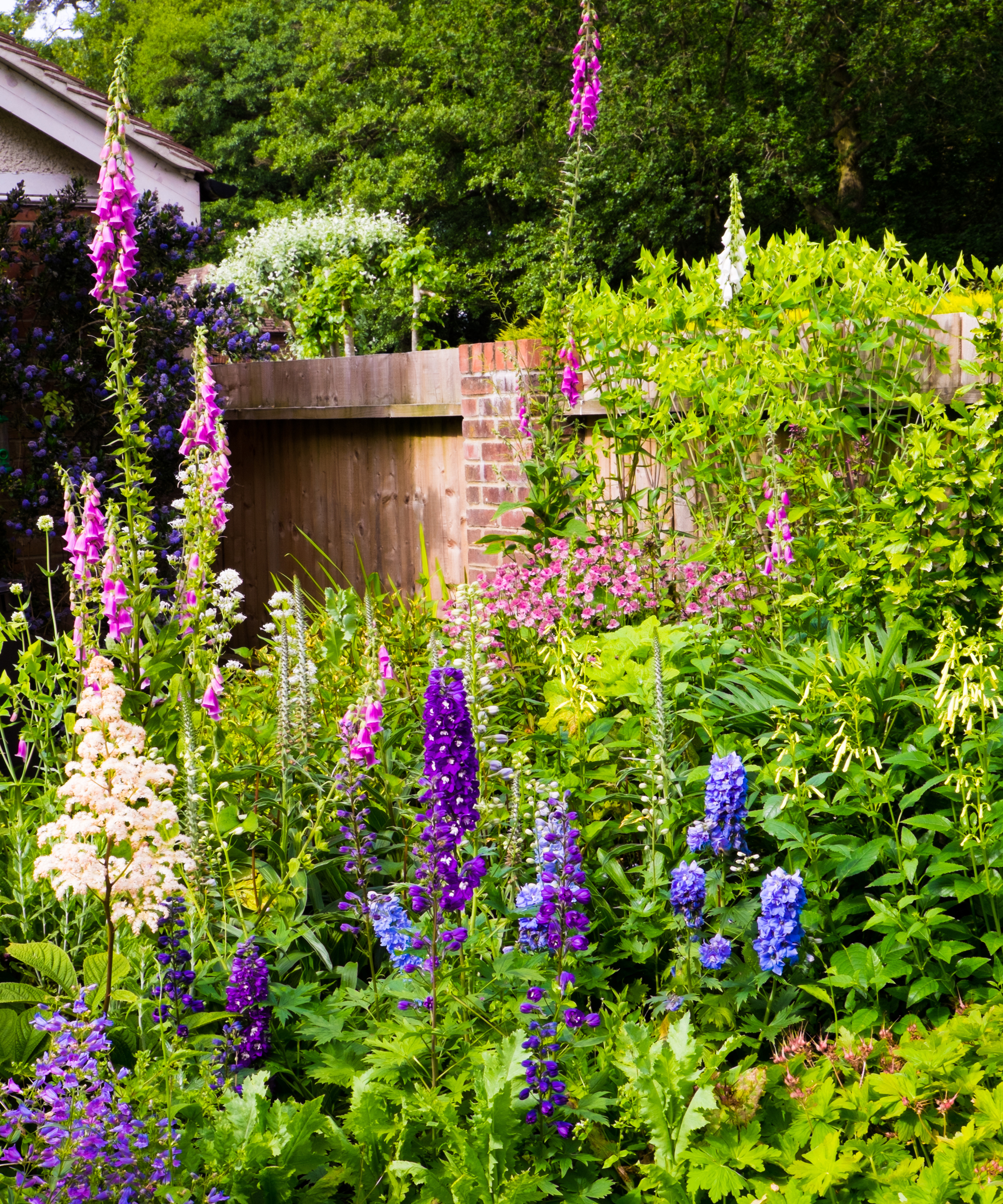
(Image credit: capdesign / Getty)
If you have a bit more patience and can wait a year, cottage garden plants such as foxgloves, hollyhocks, and lupins will grow over two metres tall – but they are biannuals and won't bloom in the first year.
15. Greenify a garden trellis
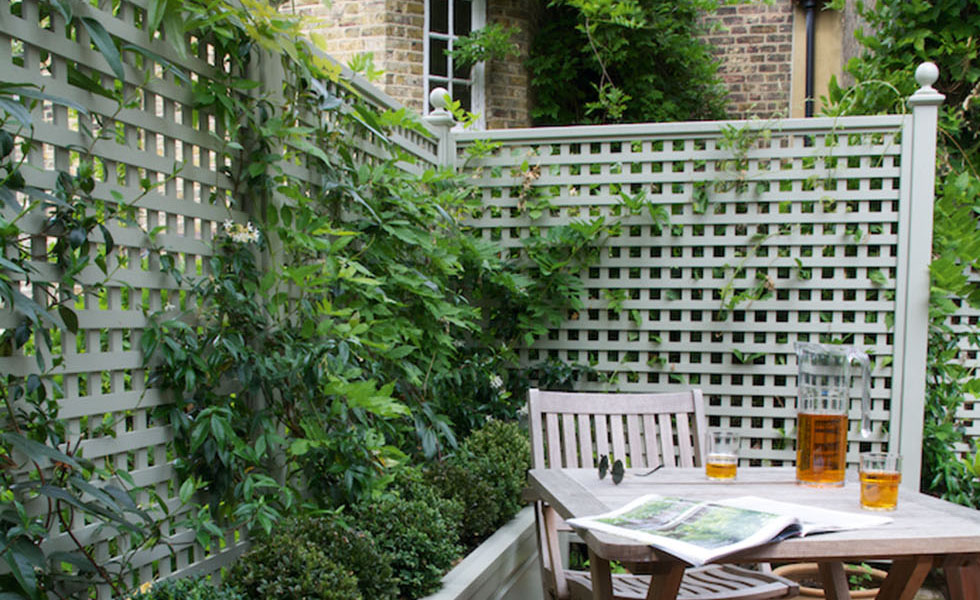
On a budget or don't want the hassle of installing new structures? You could increase your garden's privacy substantially with trellis ideas.
Remember also that your garden screening doesn't have to be solid, but just a distraction to onlooker eyes and enough to make you feel comfortable and secure in your surroundings. So, a trellis enhanced with climbers is ideal.
Choose vigorous climbing species such as honeysuckle, jasmine, and clematis, and you could have a luscious green wall by next summer! The beautiful scent these plants will bring to your garden is a bonus.
16. Or, max out on height with living walls
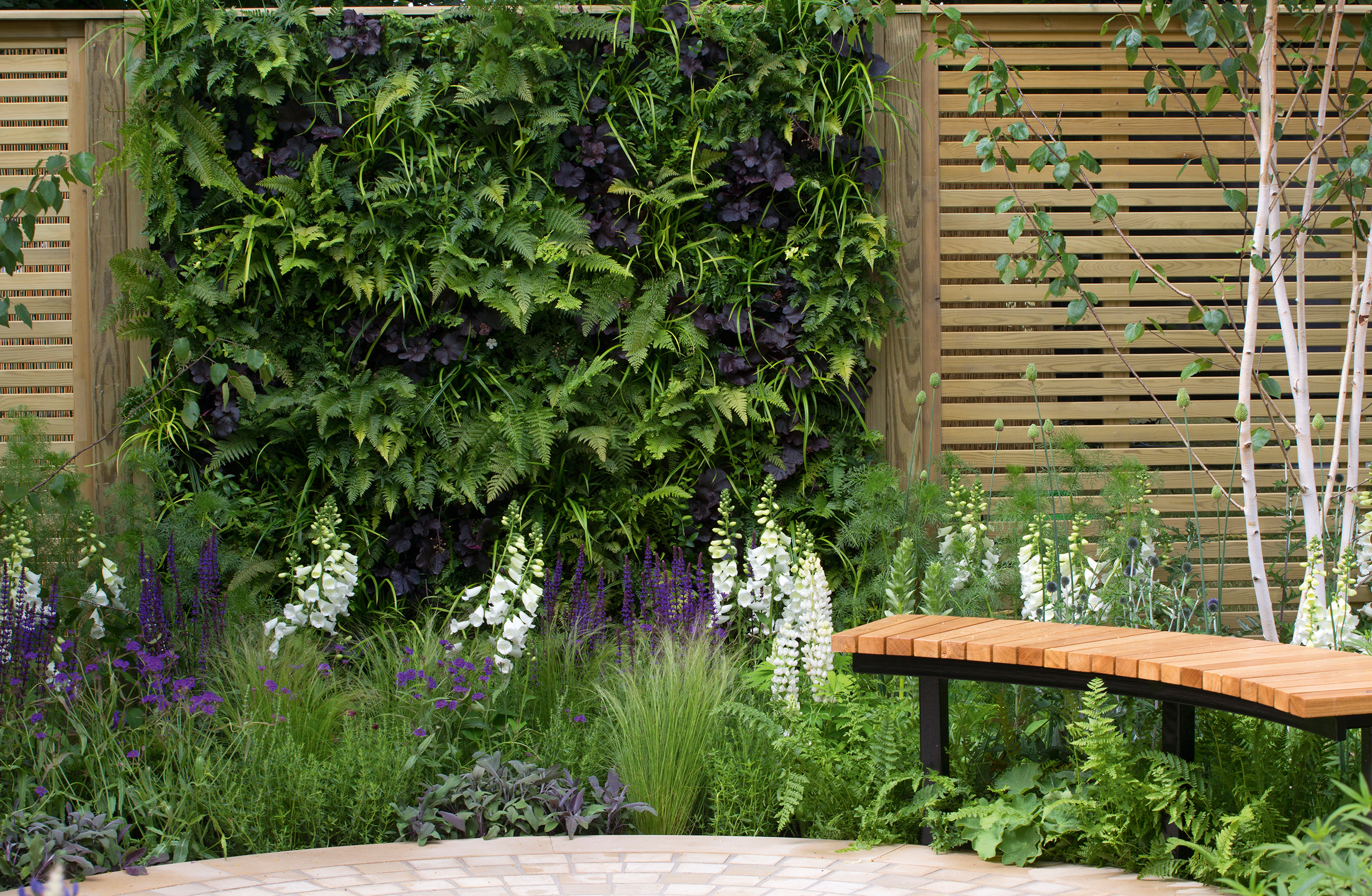
(Image credit: Leigh Clapp)
Growing a living wall isn't just a great garden screen idea, but it will also give you the chance to beautify any ugly-looking walls. The more expensive option would be pleached trees – trees trained on a rectangular frame on clear stems – that look great when extending the height of your boundary.
There are various sizes of pleached trees depending on the variety of trees you want, but often per linear metre this can run into hundreds of pounds even before the costs of planting, so be prepared to spend a bit more if you choose this option.
17. Prune screening trees for more light

(Image credit: Photo by Nathan Hulsey on Unsplash)
Remember that if you're going for trees as your garden screening option, you'll need to keep them from growing bigger than they need to be.
Prune your trees regularly to prevent them from blocking your light. The aim is to create an open shape and to avoid stimulating lots of unruly growth which will happen if you cut across a branch, for example. So keep trees as low as they can be to still hit that sightline, and prune the rest for best effect.
Learning how to prune apple trees like a pro is easy and can be mastered even by a beginner.
18. Go for semi-open garden screening for a softer look
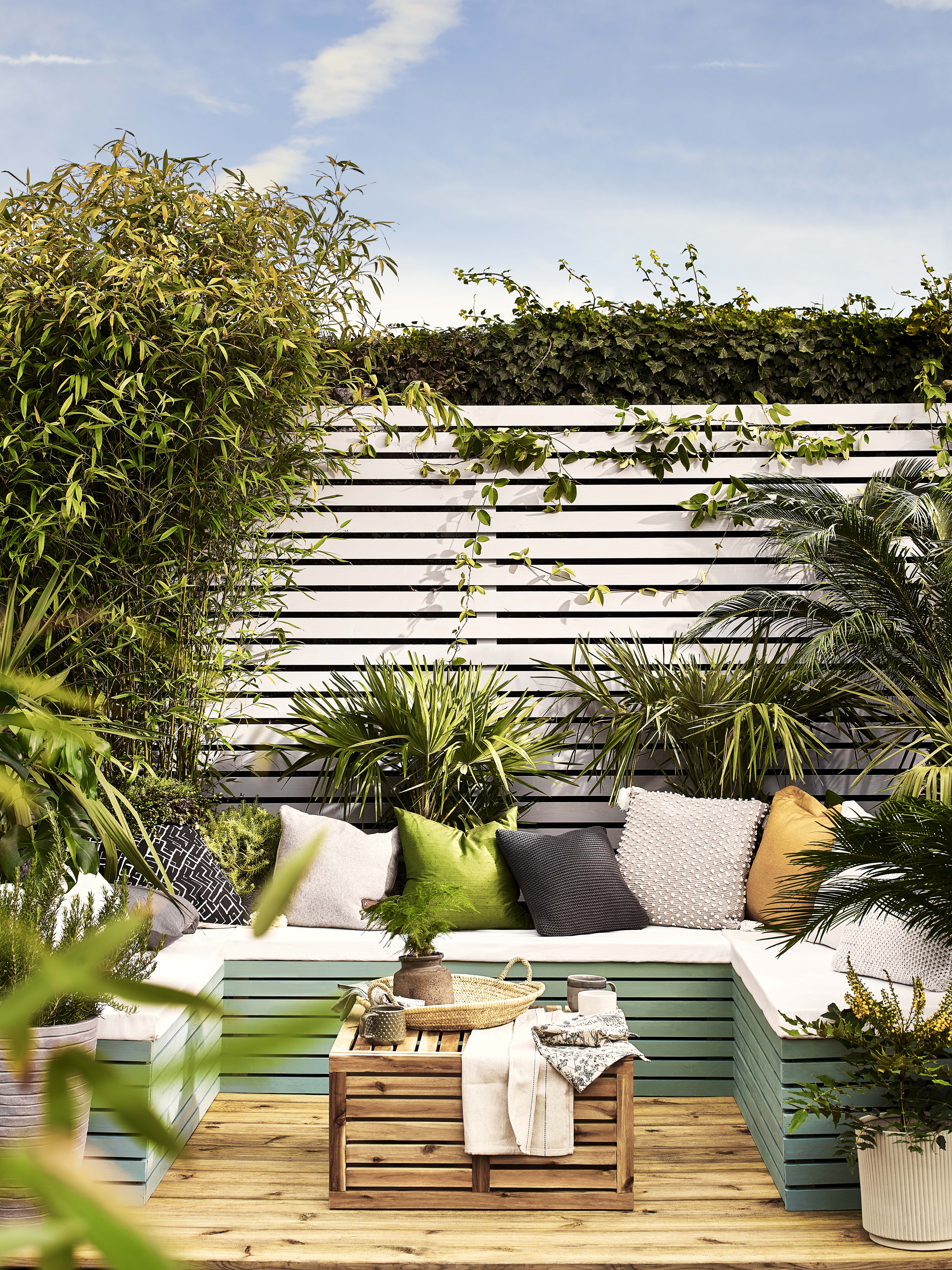
(Image credit: Cuprinol)
Just as solid hedges make gardens look gloomy and dark, so do solid fences. A semi-open or slatted design will let your garden breathe. Moreover, if your garden is small and the view beyond is quite green, an open-structure fence gives you what's called a 'borrowed view' – a classic garden design trick to make your space feel bigger.
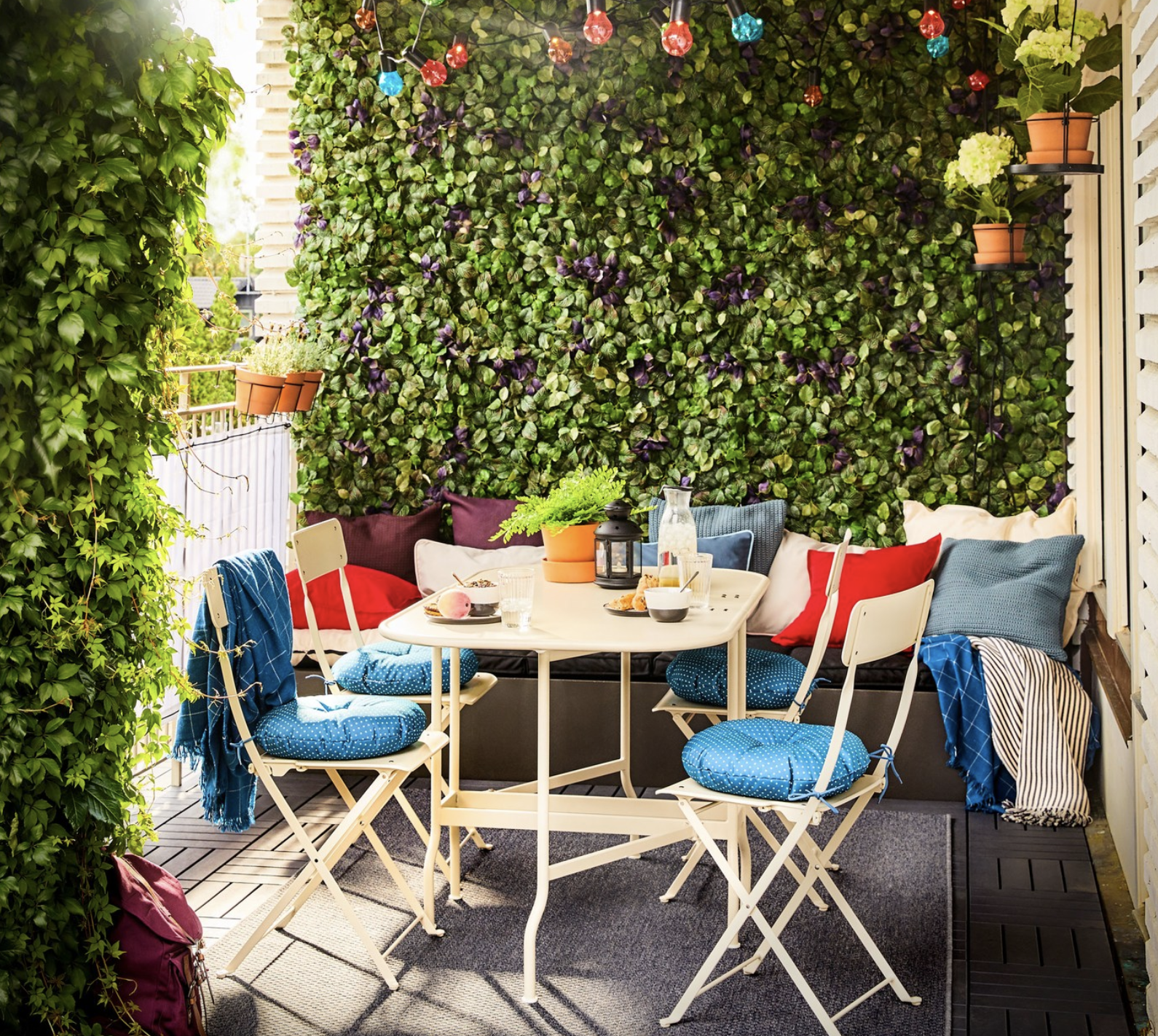
(Image credit: Ikea)
Now this is a clever garden screening idea. If you've already got an ugly wall or fence and you need a quick, green fix, particularly in a space that doesn't get much sunlight, or that has a solid surface with little room for large pots, artificial plant panels are the way to go.
Better still, you can weave real plants through them as climbers in narrow pots to create a more natural look. We like Fejka artificial panels (opens in new tab) from Ikea.
20. Install a water feature to create background noise
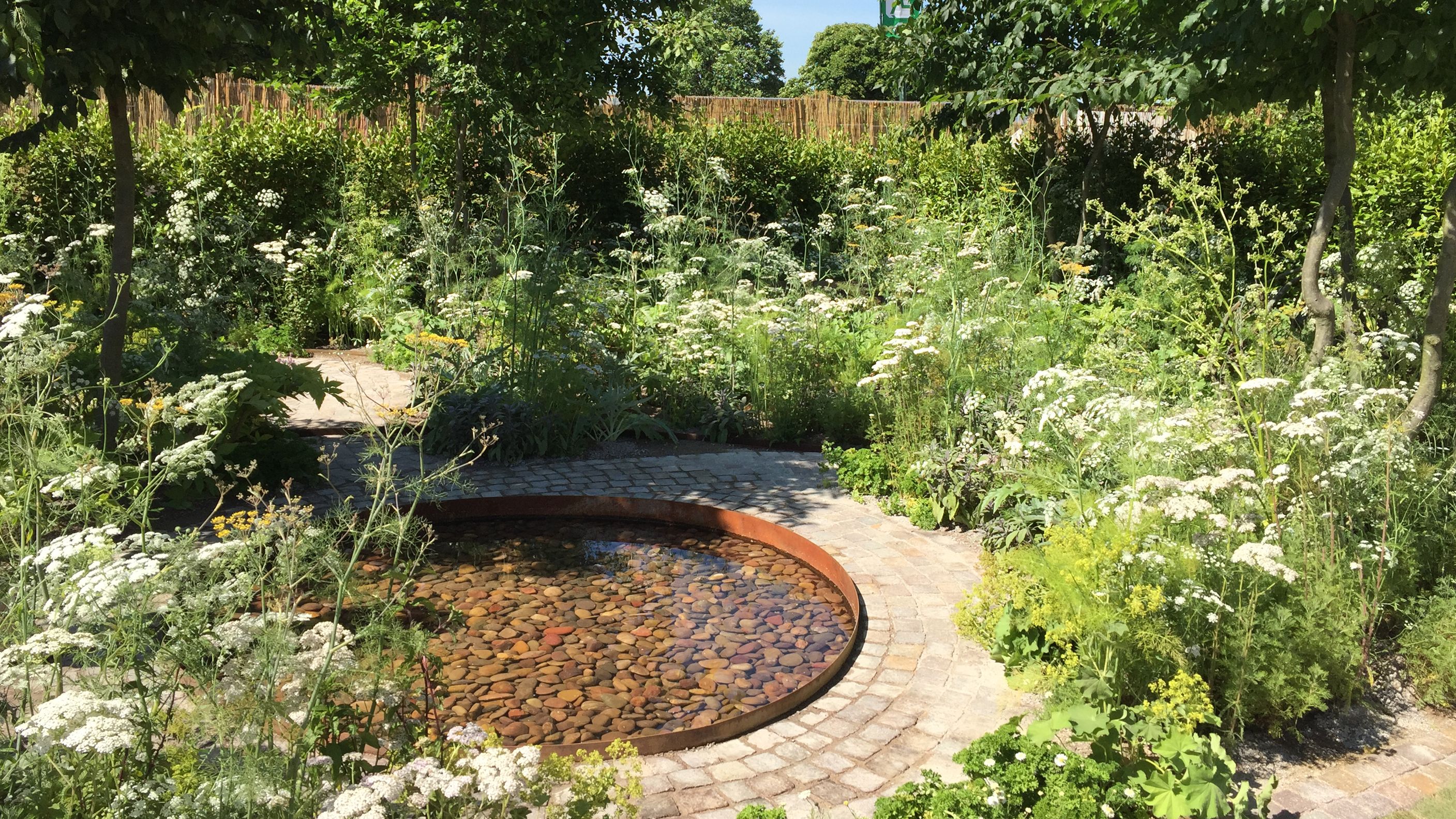
(Image credit: Karen Darlow)
To further increase privacy in your garden, consider a garden water feature.
Although a fountain or water bowl won't make a difference to the visual privacy of your garden, it will create an ambient noise that will help make conversations feel more private.
21. Add a pergola
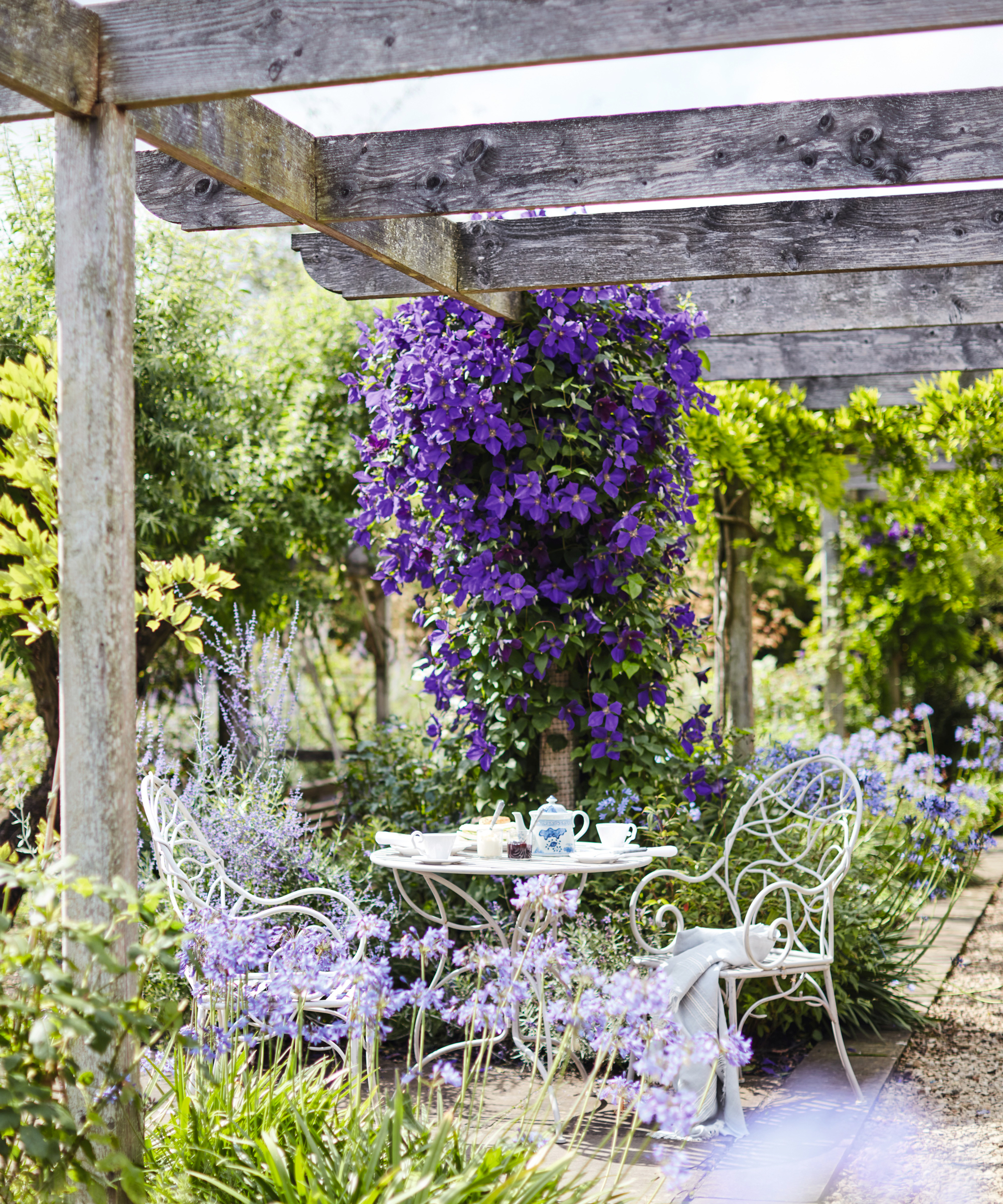
(Image credit: OKA US)
A pergola may well provide enough privacy in a smaller garden. Even better, if you enjoy DIY, you can build a pergola yourself. Add some hanging baskets full of petunias, ivy, and lobelias to create even more privacy.
22. Or, an arbour
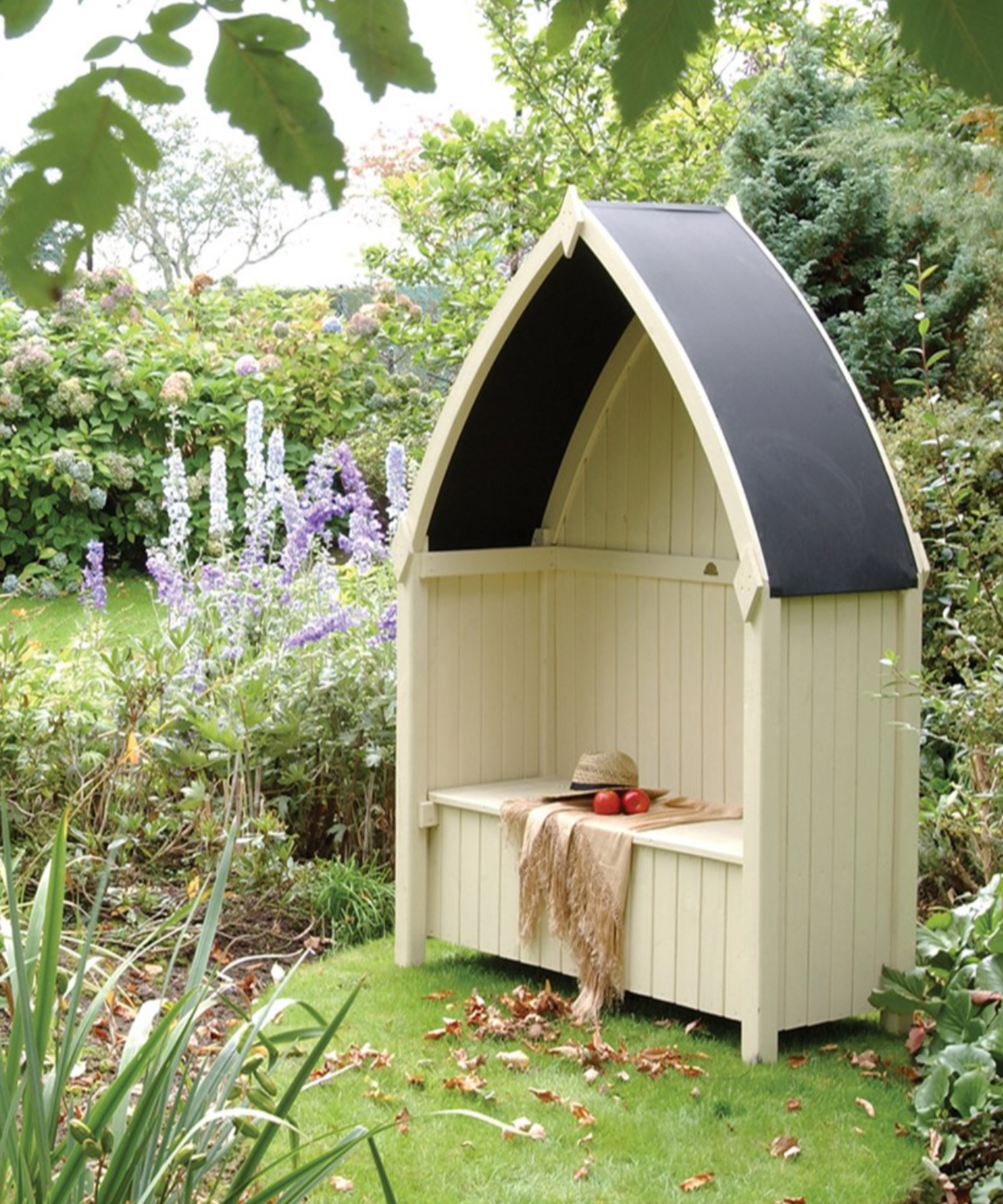
Rowlinson Winchester Arbour (opens in new tab) from Cuckooland
(Image credit: Cuckooland)
Alternatively, invest in an arbour for a fuss-free, instant secluded nook where you can while away warm days feeling totally at ease. An arbor is just an enclosed bench or seat, usually made from wood. Some options can be combined with climbing plants for a two-in-one screening solution.
23. Make a statement with a contemporary screen
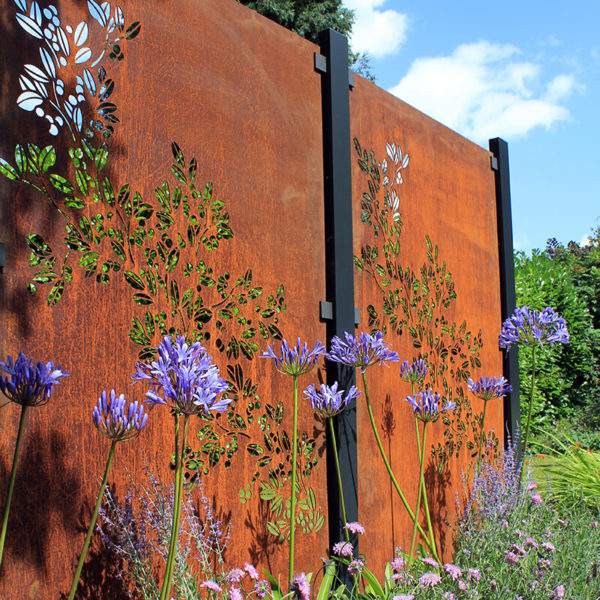
(Image credit: Primrose)
One of our bolder garden screening ideas that we adore. It does the job of adding much-needed privacy, as well as making a design statment with beautiful contrasting color and a cool texture. This characterful metal fence is made from croten steel and creates the perfect backdrop to show off fancy planting. It's an investment, with a price tag to match but not one you will regret. The garden screen panels are available from Burford Garden (opens in new tab).
24. Go au naturel with bamboo
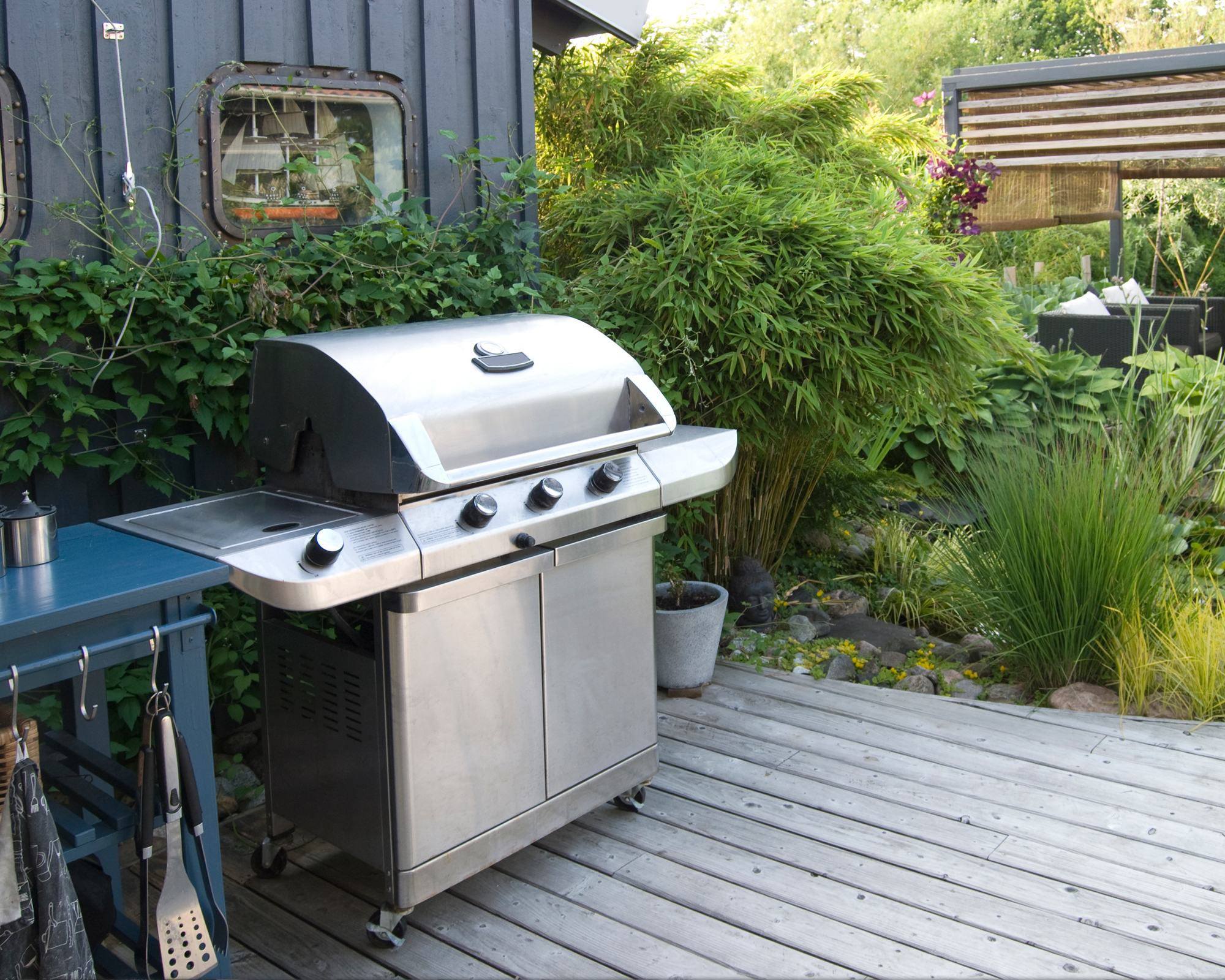
(Image credit: Eirasophie / Getty)
(opens in new tab)
Bamboo is easily the best plant to grow as garden screening. It's beautiful, most varieties are evergreen, and it grows tall very fast. Many varieties will grow up to 10 metres tall if you let them, and you can achieve this natural tall screen in a matter of a couple of years. The only thing bamboo needs to thrive is plenty of water, so don't forget to water it during periods of drought.
Just be mindful of it's invasive nature. You may want to contain it in troughs or planters to stop it overtaking your garden.
25. Add curtains to an outdoor room
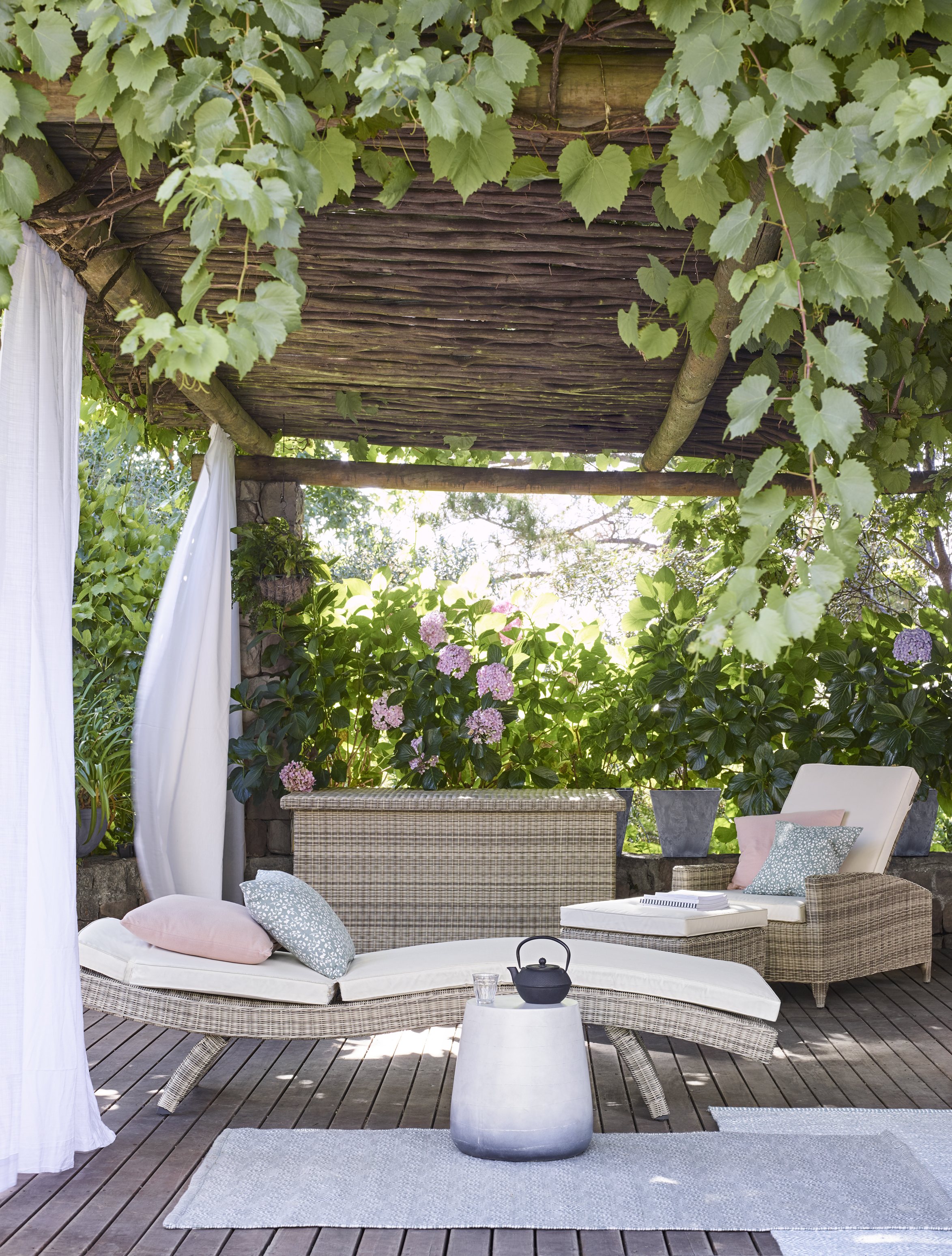
(Image credit: John Lewis)
For the perfect outdoor living area where you want privacy from all angles, adding billowing curtains to a covered spot will not only look gorgeous and very chic but it will also mean that when you want more privacy.
Be that from neighbors or the kids, you can hide away easily.
26. Don't forget your front garden
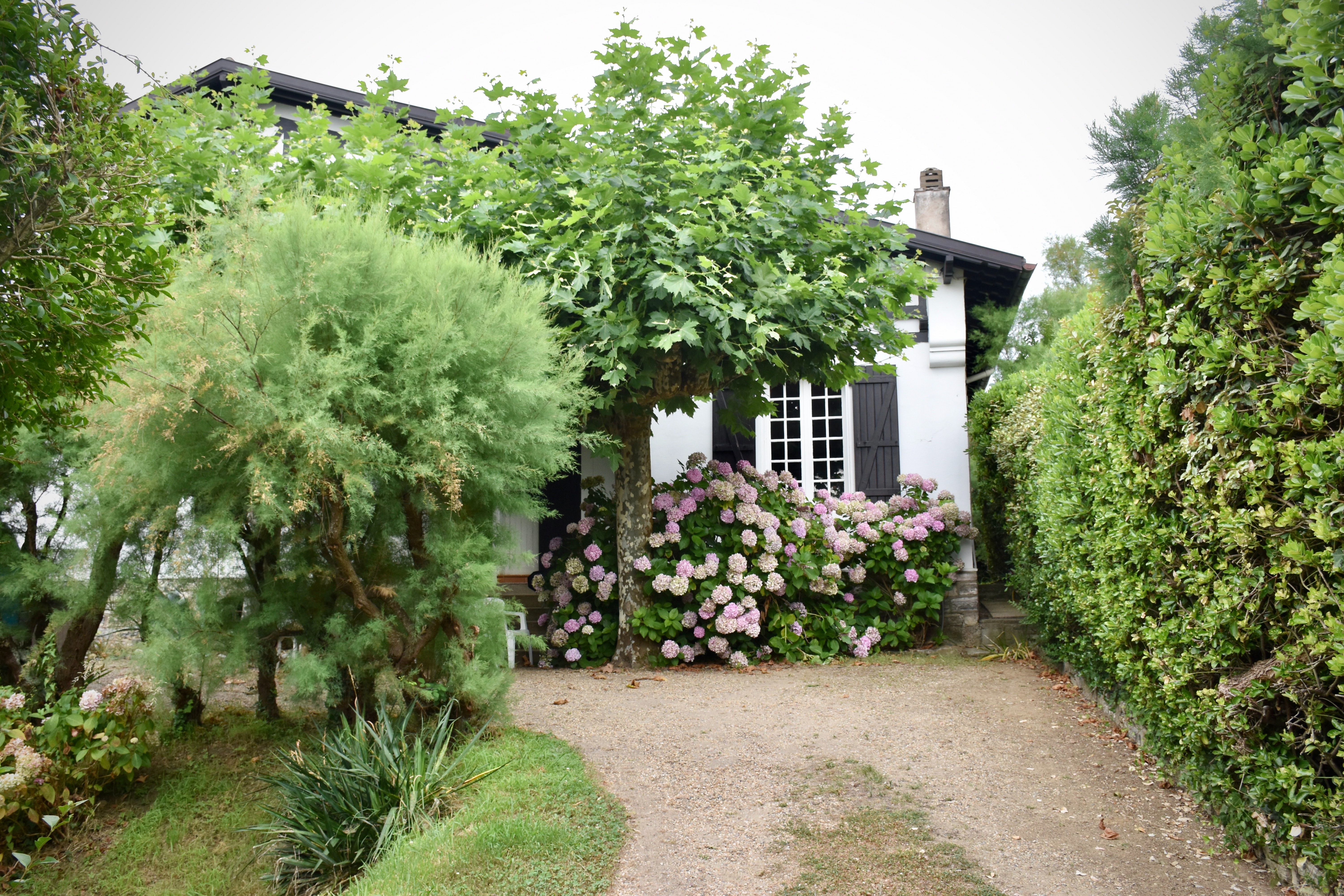
(Image credit: Unsplash/Arno Senoner)
Want a completely natural scheme that creates privacy without the use of screening materials as such? Pick your plants wisely. Especially in front gardens, bushy trees with dense foliage, such as acacia, yew, and junipers can easily provide enough screening to not need anything else.
You can also use bamboo, but bear in mind that some varieties can grow very tall very quickly, so you'll need to keep it under control by regular trimming.
27. Plug gaps in fencing with blooming shrubs
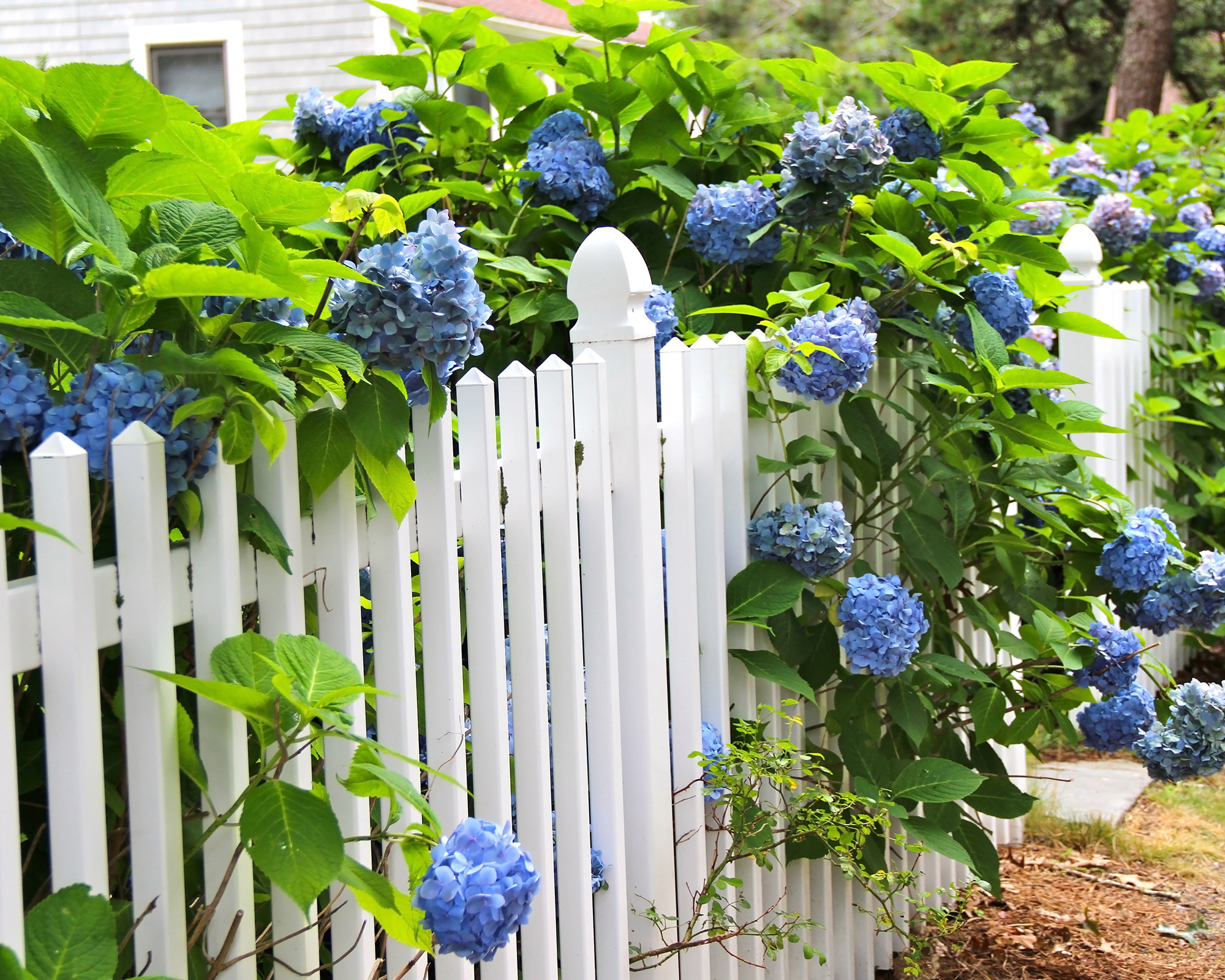
(Image credit: Olenaa / Getty)
If you've installed a low fence and are finding that it's not doing much for your garden privacy, you can easily enhance what you've got with dense, blooming shrubs. Hydrangeas are perfect for this – their blooms are so abundant and large throughout the summer and autumn that you likely won't need anything else. Or try lilacs.
28. Consider a potting shelter
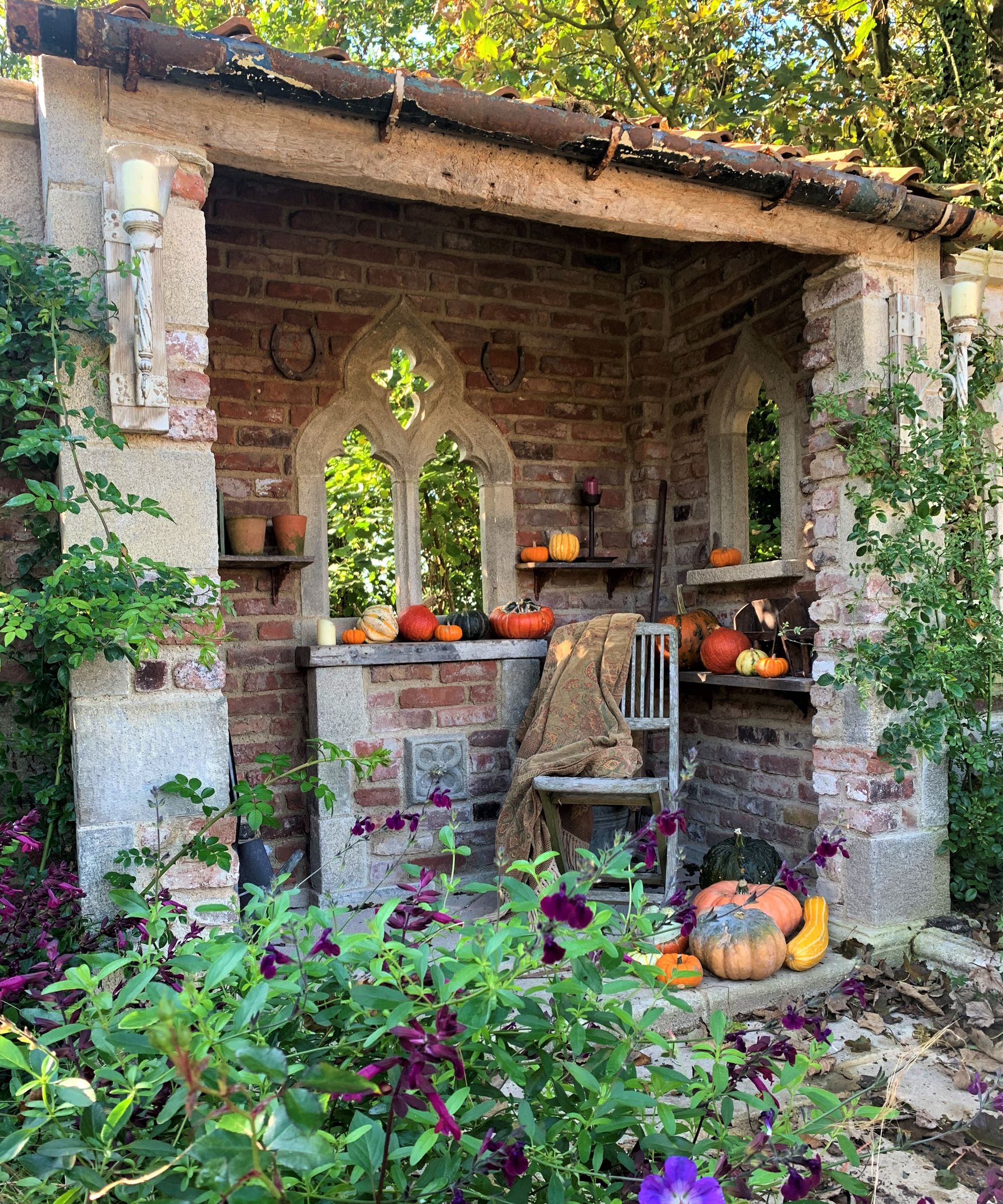
(Image credit: Redwood Stone - Folly & Garden)
It's not quite a garden shed, and it's not quite a garden wall, but something between the two, providing you with garden storage and a dedicated space for potting plants. To say nothing of doubling up as a garden screen. We adore this Potting Shelter by Redwood Stone (opens in new tab) – you could try building something similar yourself if you've worked with brick before.
29. Don't be afraid of an overgrown garden
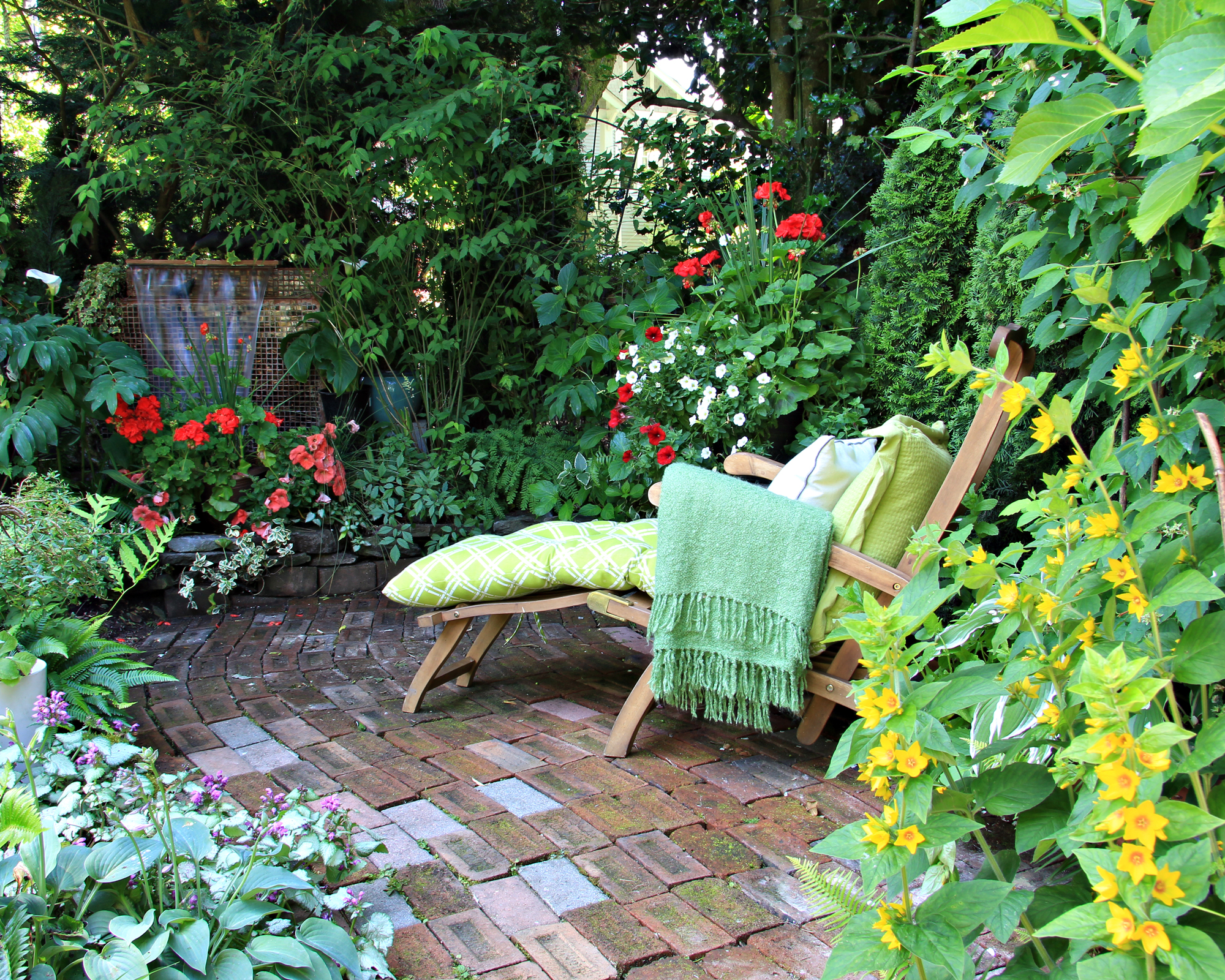
(Image credit: HannamariaH / Getty)
Sometimes the best strategy is to just let nature do its thing. Let your plants grow more naturally, resisting the urge to prune everything. You will be rewarded with a luscious, secluded garden where you may not need any manmade screening at all.
30. Use tables and plant stands to add height
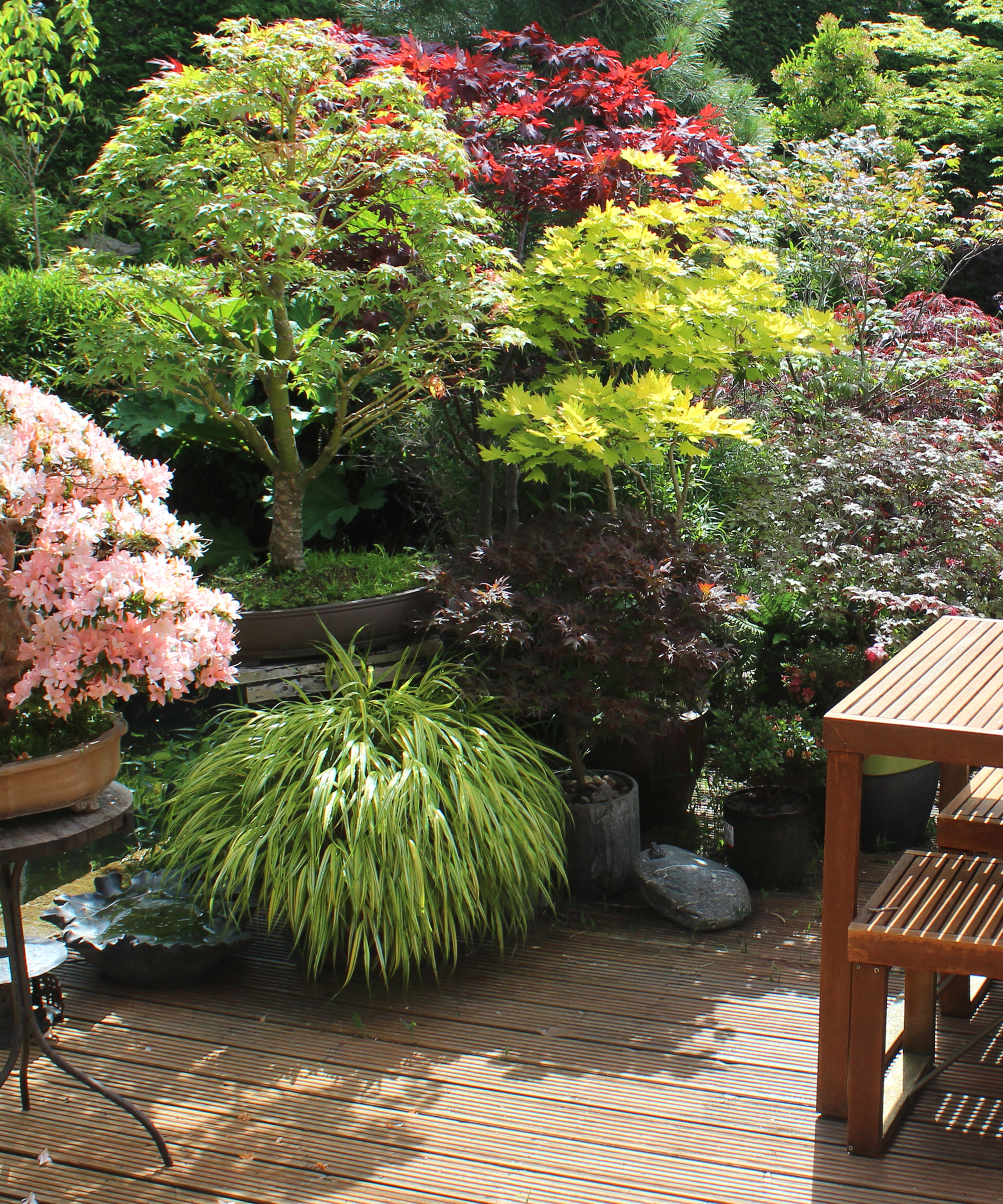
(Image credit: mtreasure / Getty)
The most common problem gardeners have with natural screening is that it's uneven, with visible gaps at awkward heights. This is especially common if all your plants are around the same age, which will mean that you're lacking density in the middle of your natural screening scheme. If this is the case – plant stands and garden tables to the rescue! Use garden furniture to adjust the height and balance out the look of your living screen.
What are the best garden screening ideas?
There are so many elements that come into play with garden screening. Not only will you want to create privacy, hide eye sores and minimize noise in your garden by use of good screening, but you'll also want to protect light levels and your garden's aesthetic also. So choosing options that aren't overbearing is key.
Most gardens are overlooked, especially if you live in a terraced house, either by windows from the houses backing onto yours, from other floors in your block if you live in a flat, or from people next door.
And the way that many people used to solve this was by planting conifers around their entire border. As lovely and effective as that is, the downfall here is that these trees grow very large, overbearingly so and they will then cast a lot of shade on your garden space over time, which isn't necessarily what you want. Find the best option above to suit your garden space.
How much does garden screening cost?
In terms of cost, this depends very much on the type of screening you go for. Shop bought screens, trellis and the like cost anything from £25/$30 and upwards and if you're choosing natural boundaries it depends on the type and size of plants or trees you want to put in place.
There are many nurseries where you can buy larger-sized deciduous trees to mix with a semi mature evergreen specimen such as Thuja occidentalis 'Smaradg' or Taxus bacatta fastigiata (columnar yew). Many nurseries will deliver and plant trees and hedging for you also which in itself can be expensive.
The DIY route and working with nature is of course the cheapest solution and often the most effective (and satisfying) way too if you ask us!
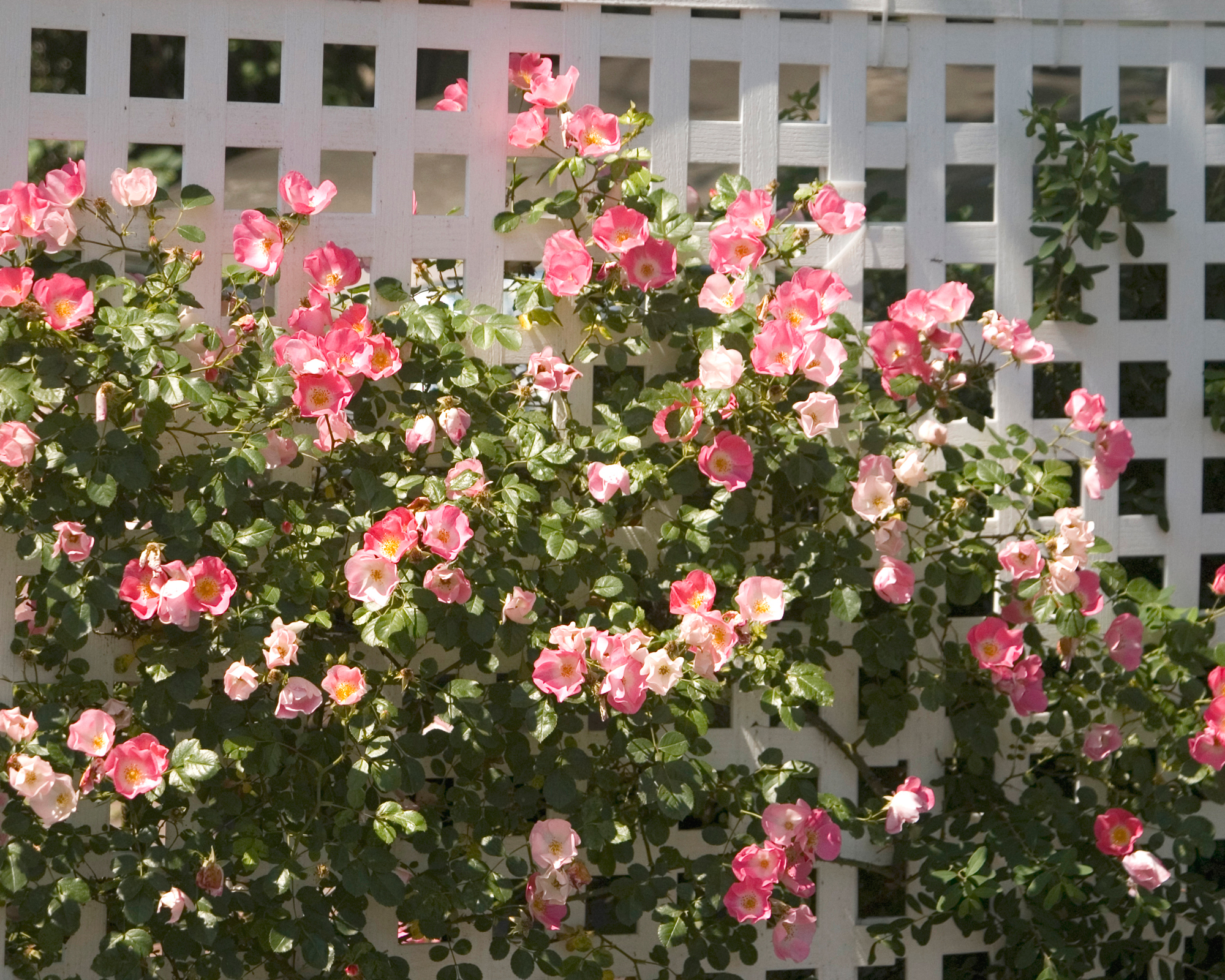
(Image credit: jcarroll-images / Getty)
Choosing simple ways to increase privacy like planting and DIY can make this job really budget-friendly and nonetheless effective. The experts at Gardening Express say that aside from DIY solutions, 'another alternative is wire garden fencing, as it is quick to install and unbelievably cheap. Growing climbing plants like a colorful clematis or ivy up the wire will create a private space and a great place to nature spot.'
So it can be done. Always start by assessing where you really need privacy and consider both temporary and permanent options to suit your needs and garden's orientation. This will make it a lot easier to find a happy medium.
And remember that unless you want to zone off your entire garden – for which you will need to check what's allowed beforehand – you will be able to get more privacy in other less dramatic and very clever ways.
Source: https://www.realhomes.com/advice/how-to-improve-privacy-in-your-garden
0 Response to "Easy Way to Create a Wall for Privacy"
Post a Comment